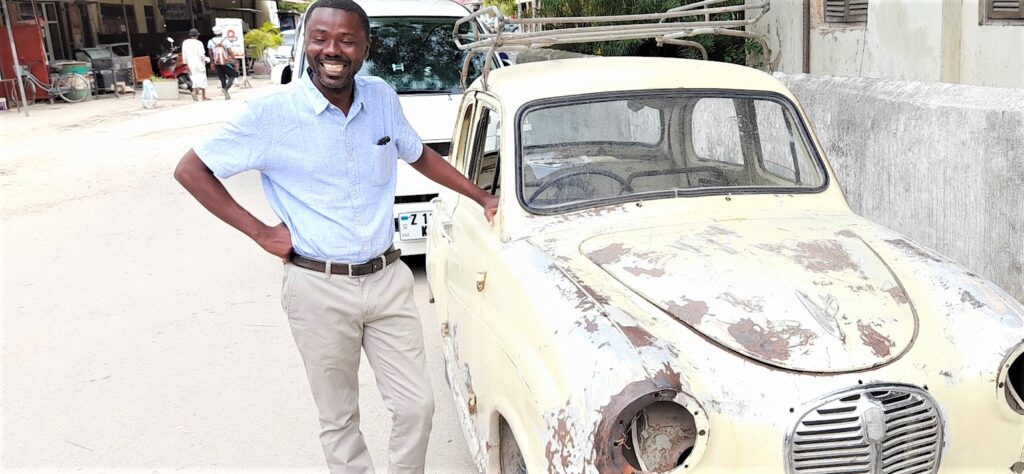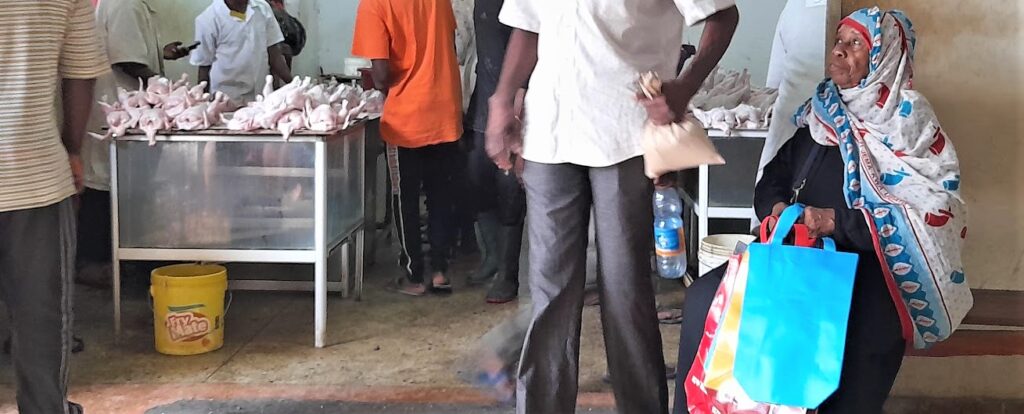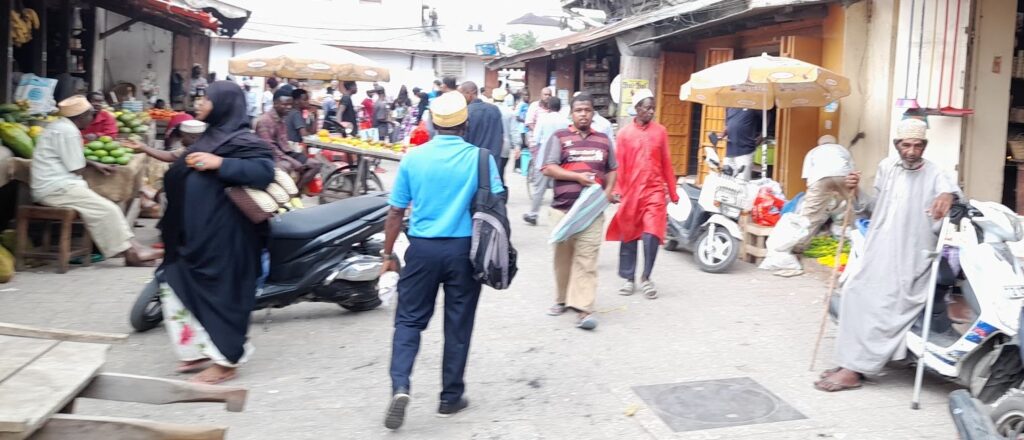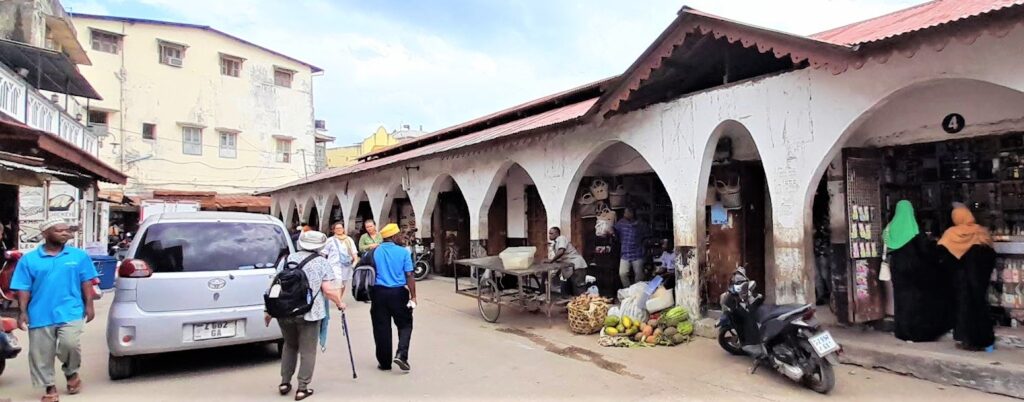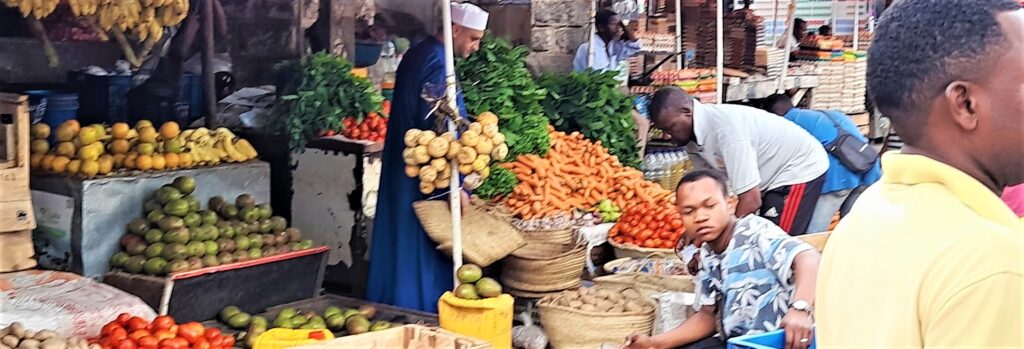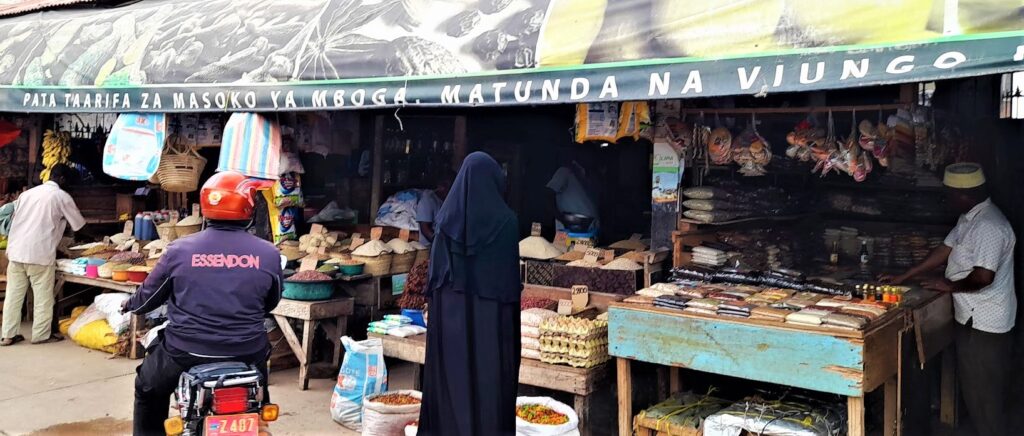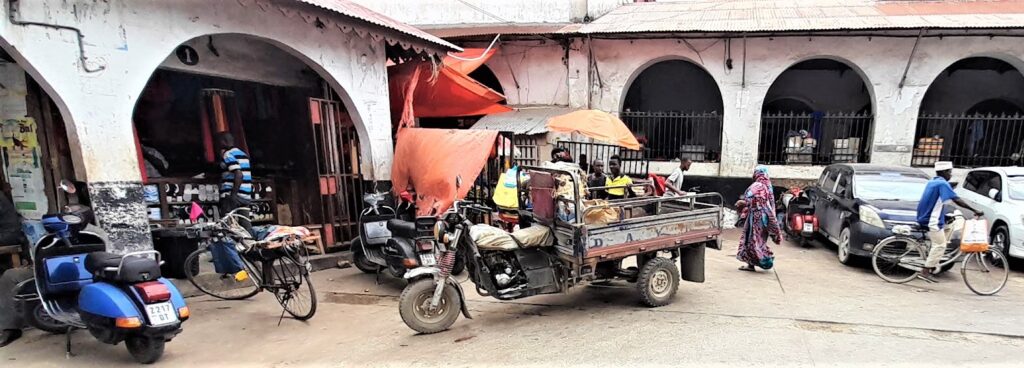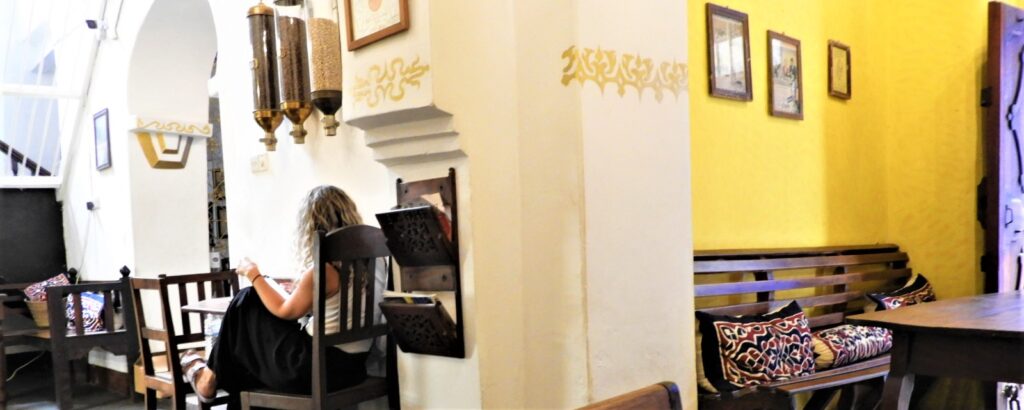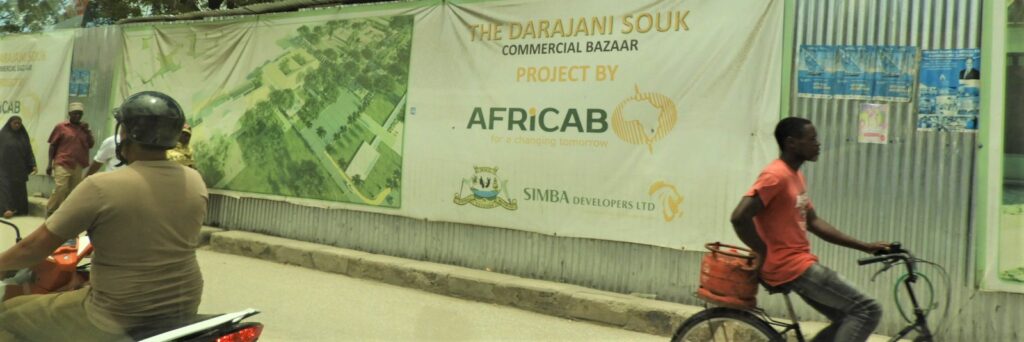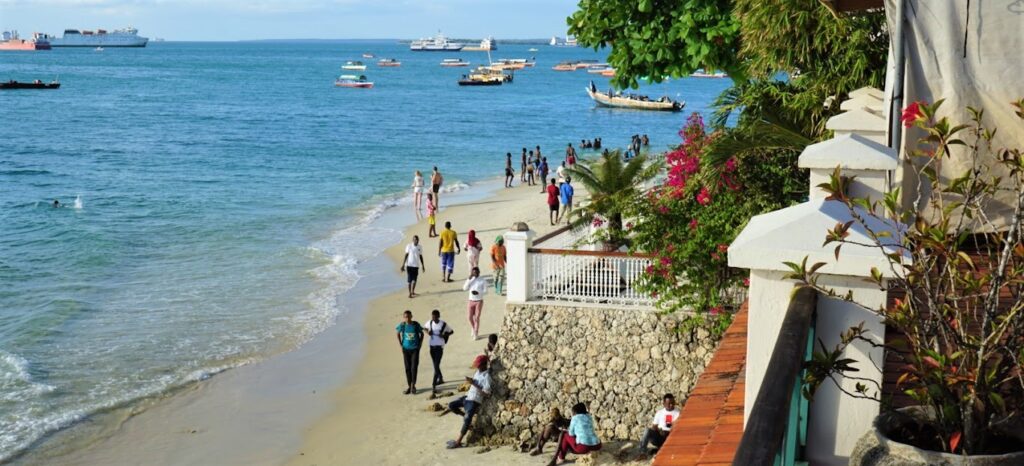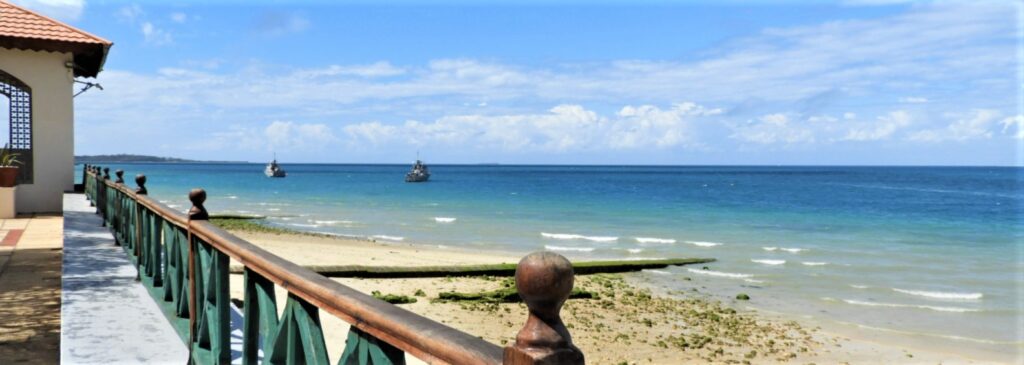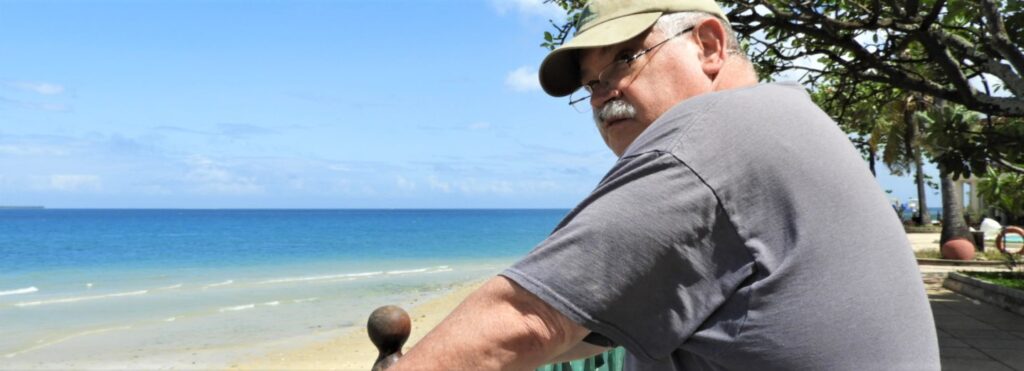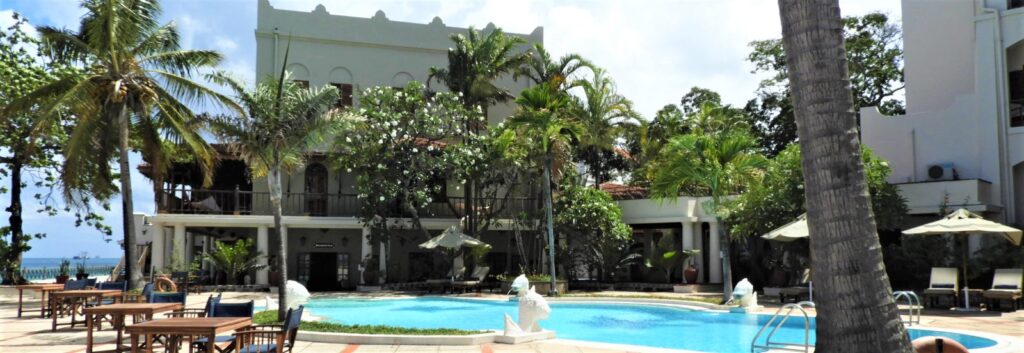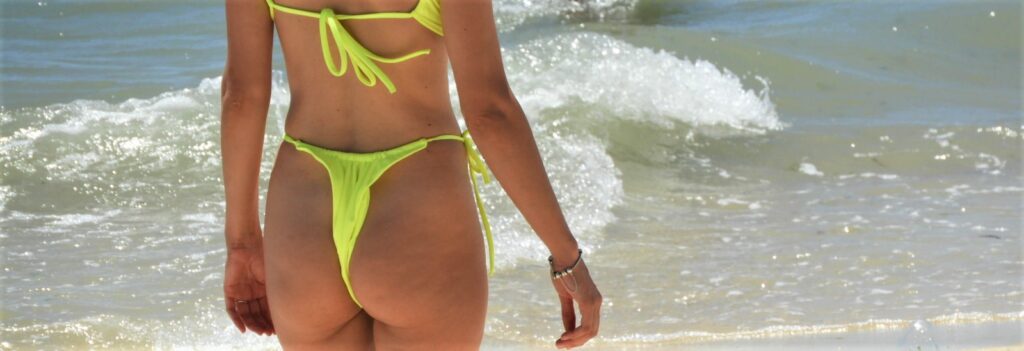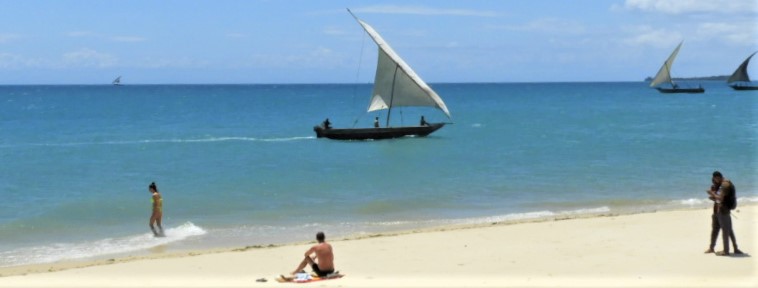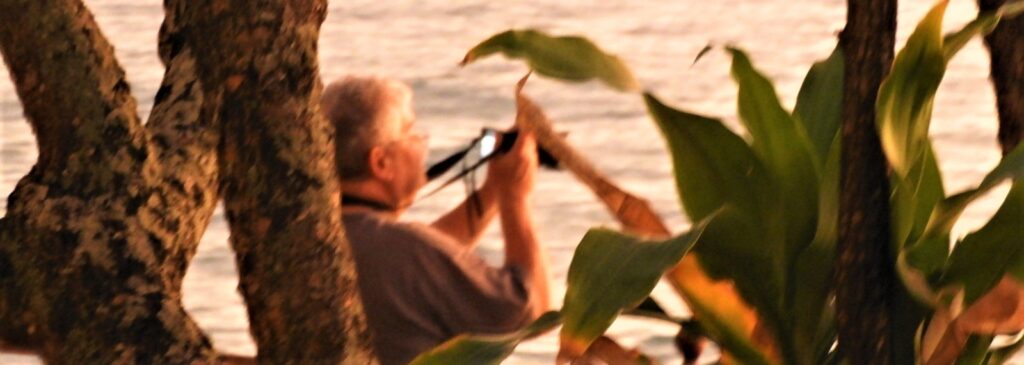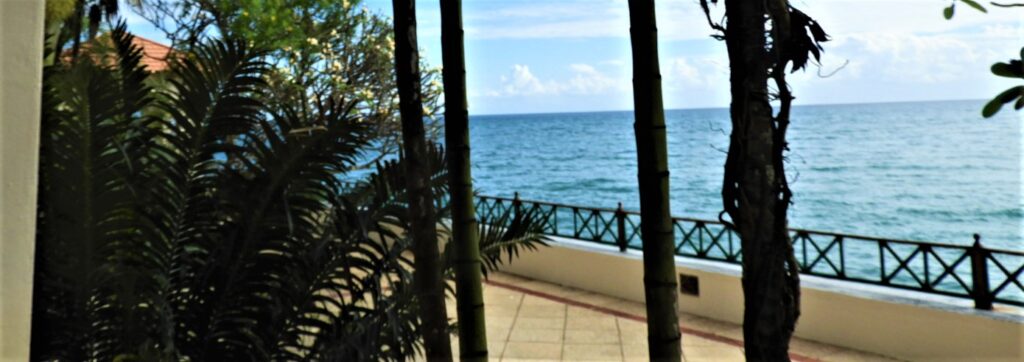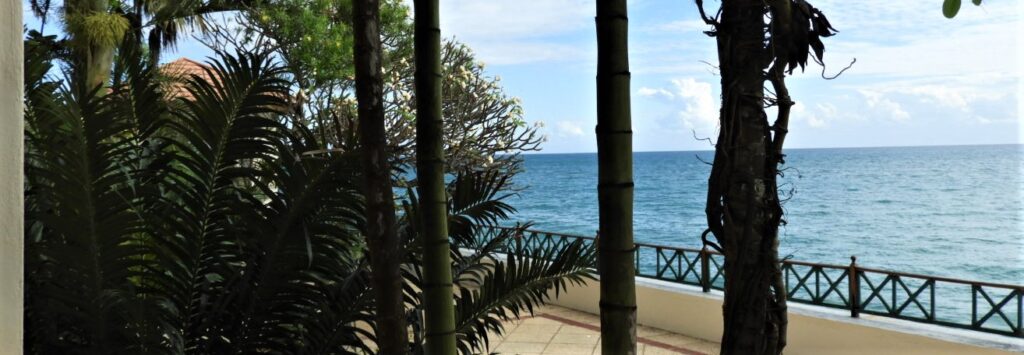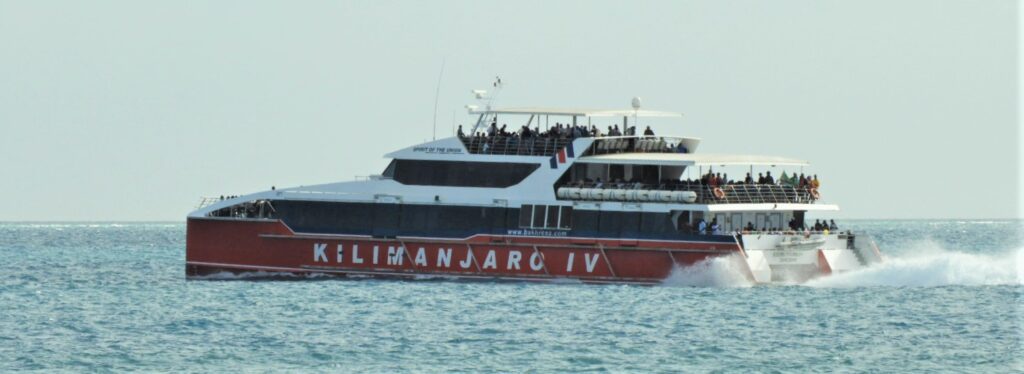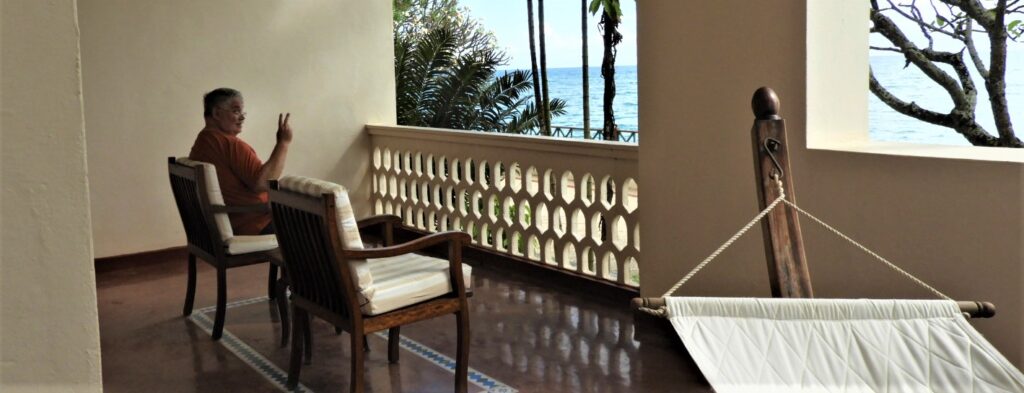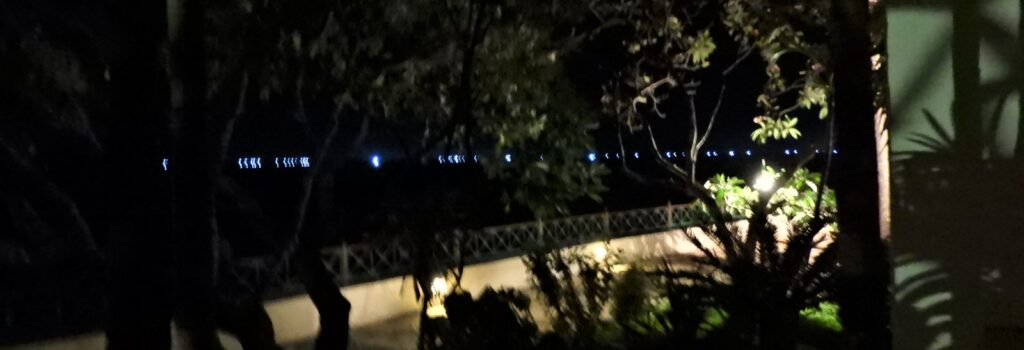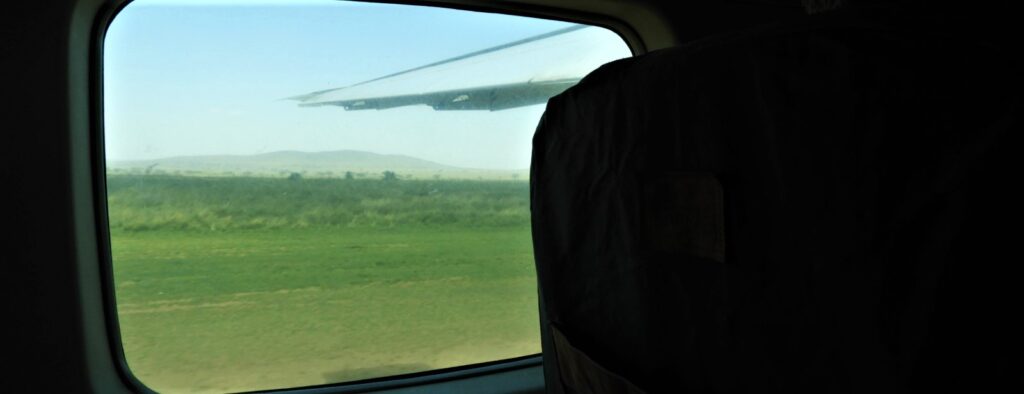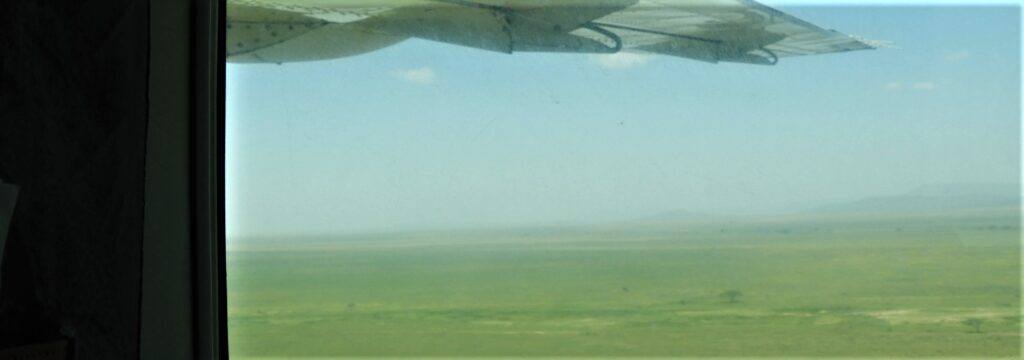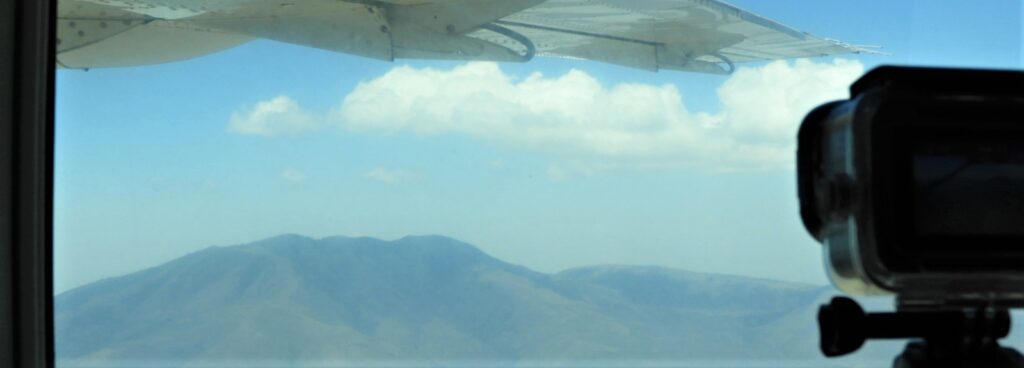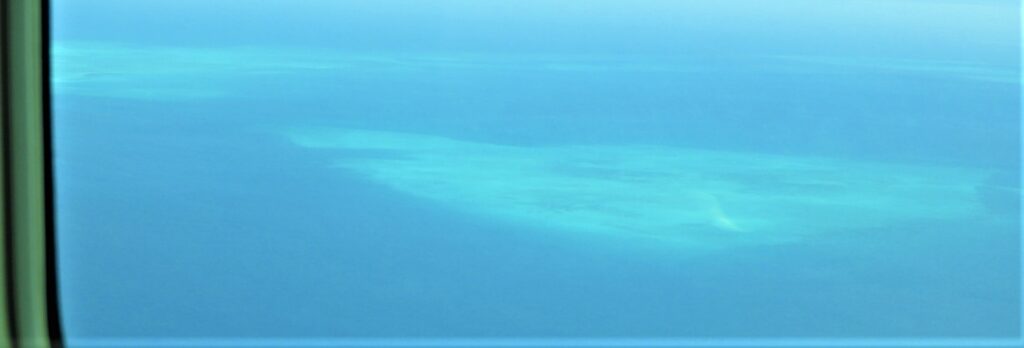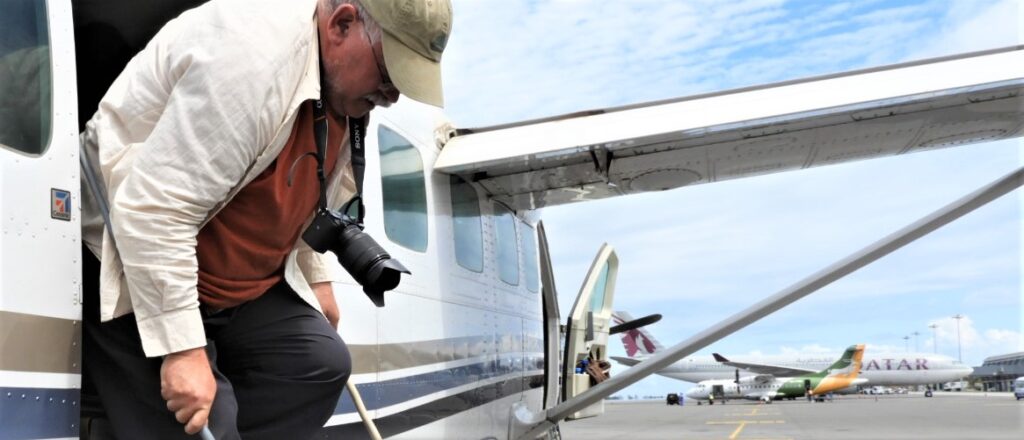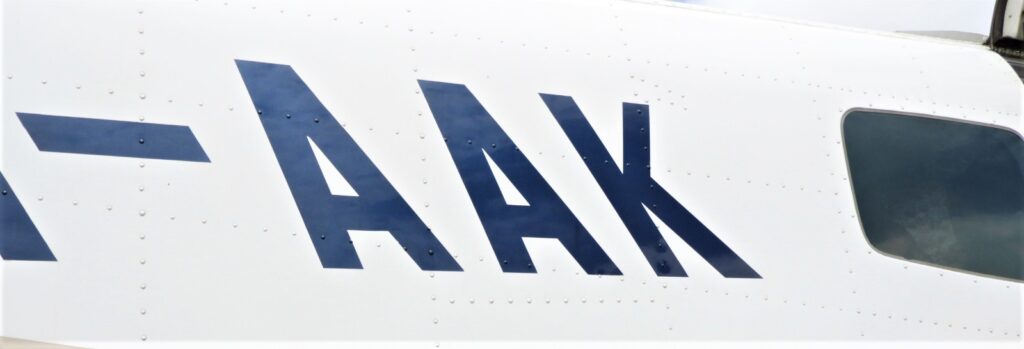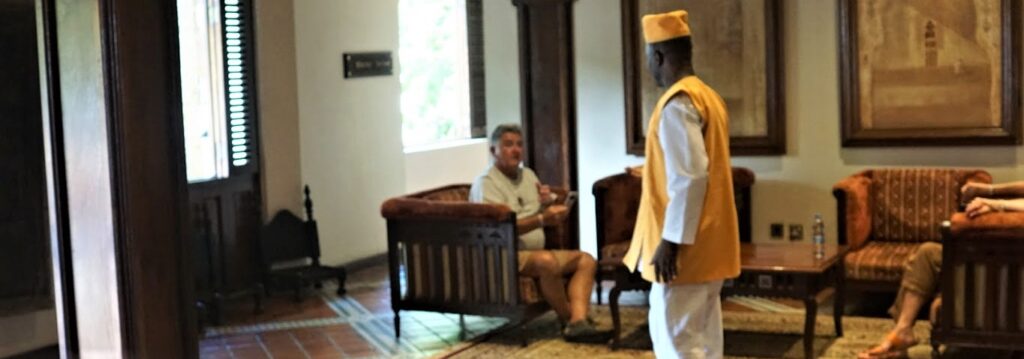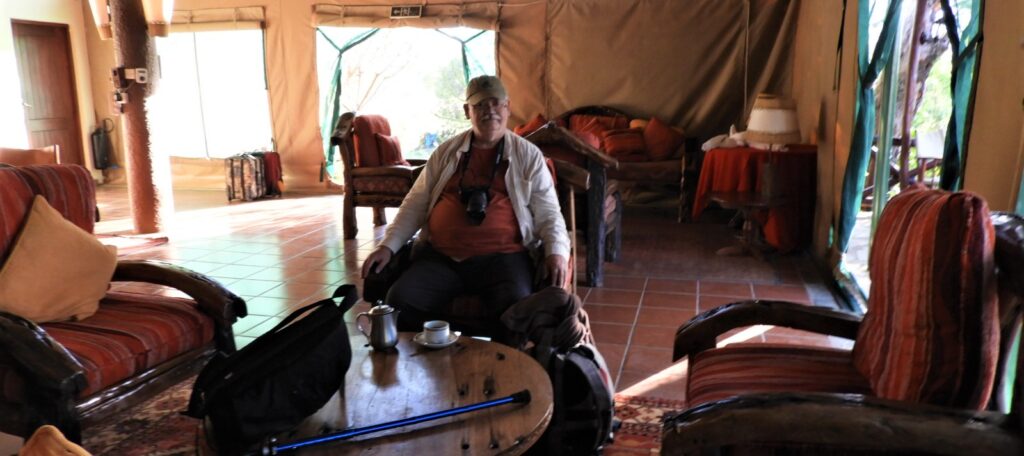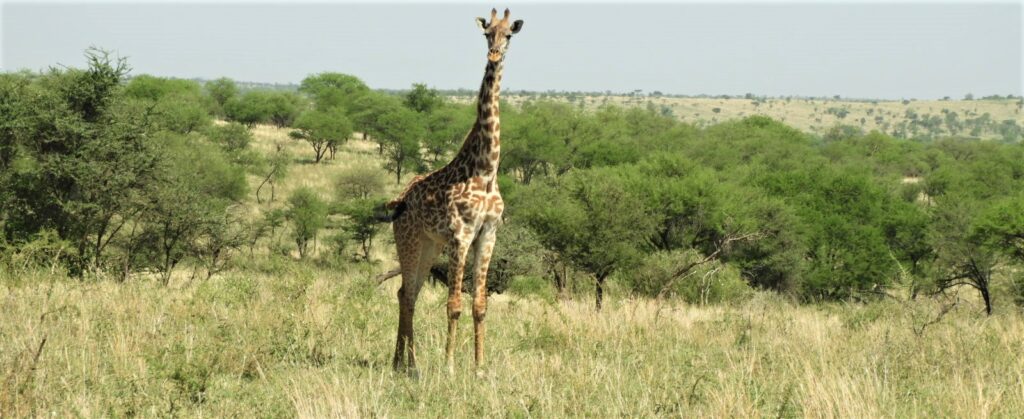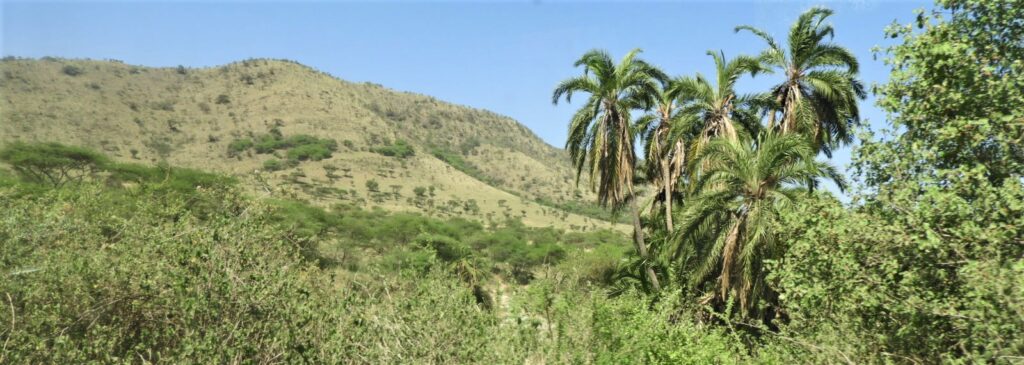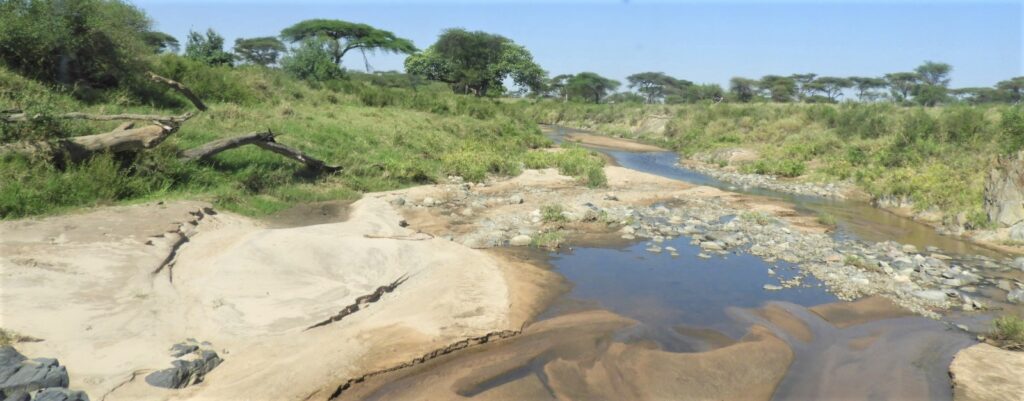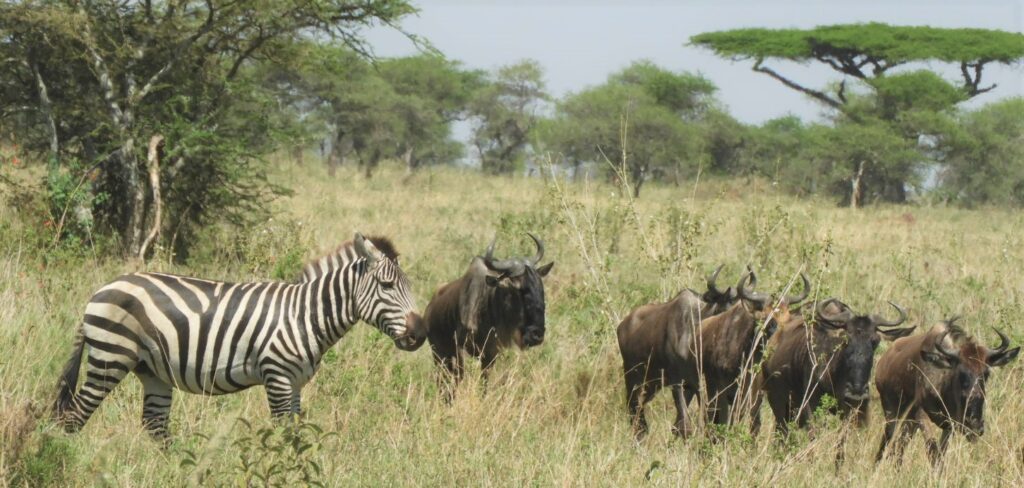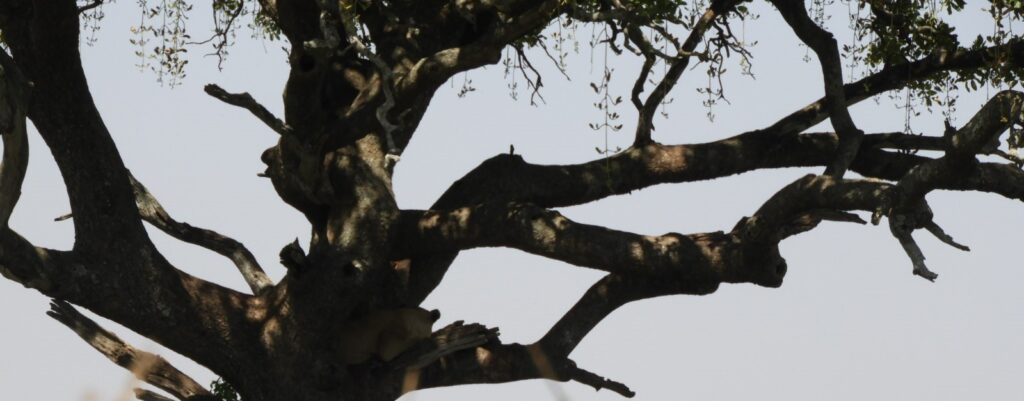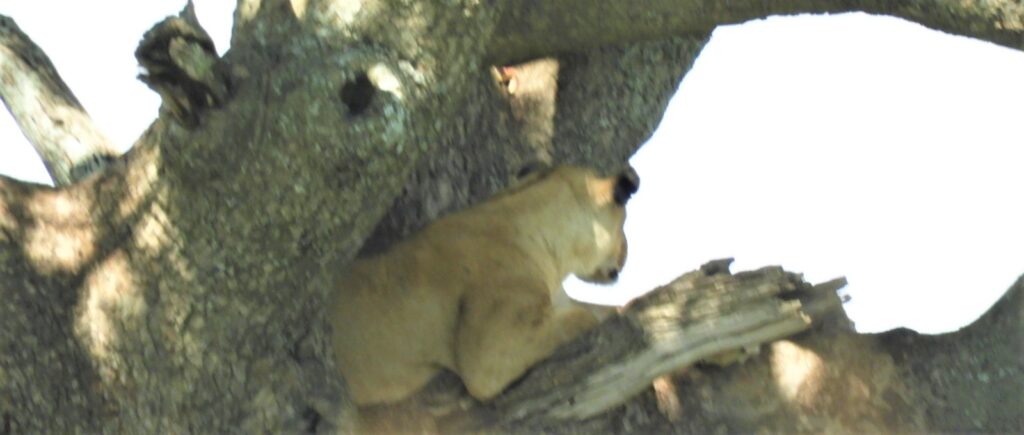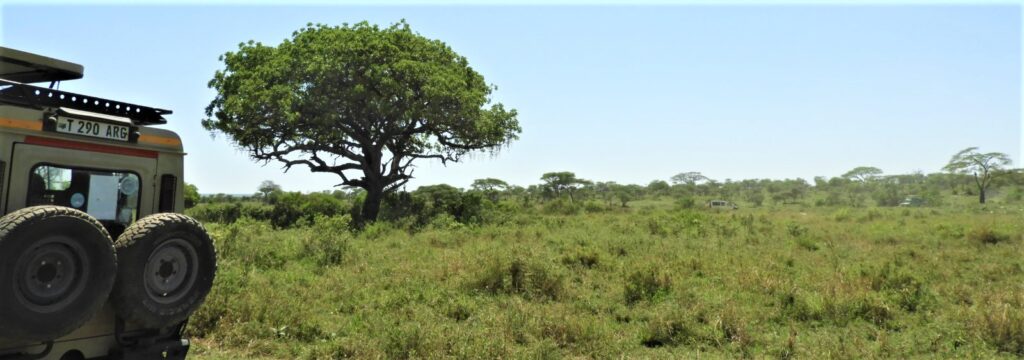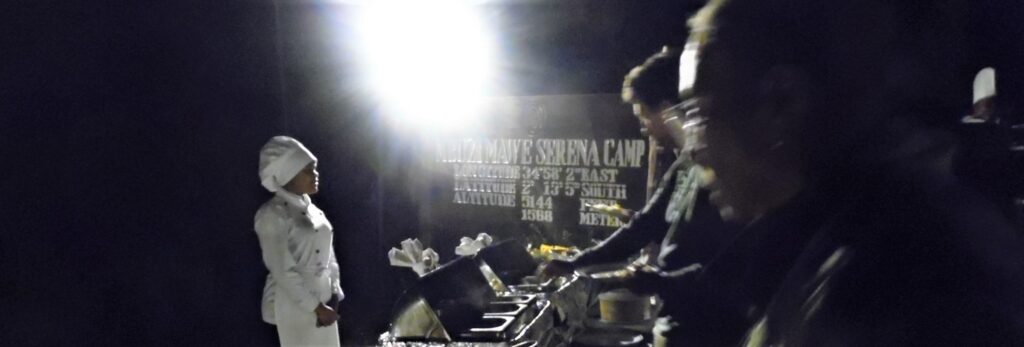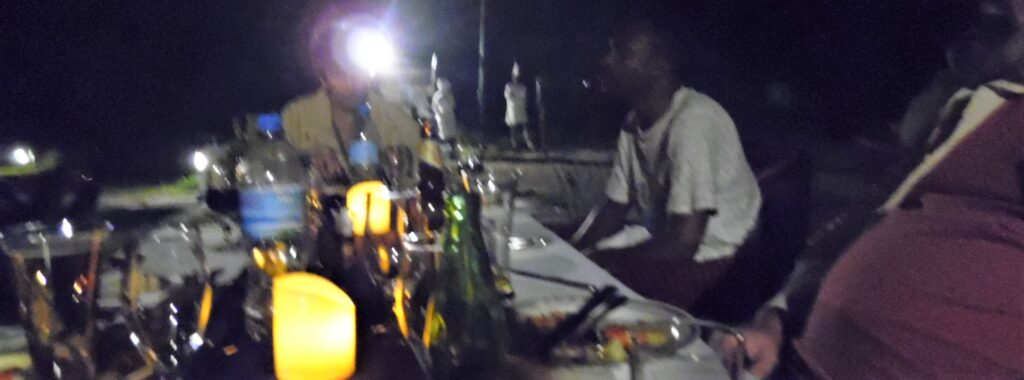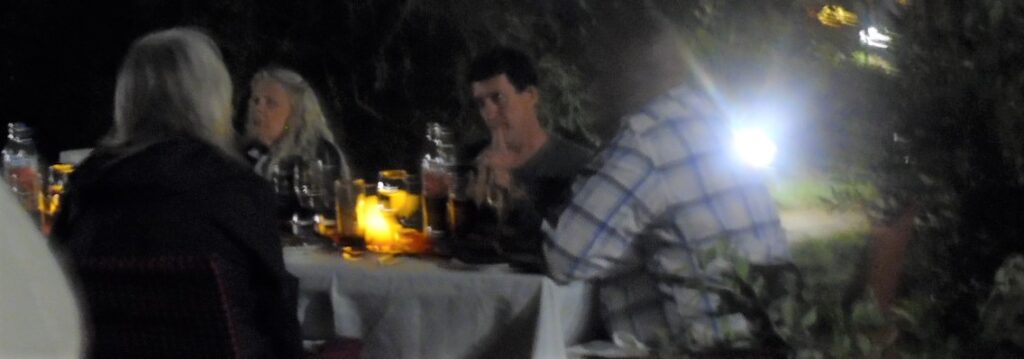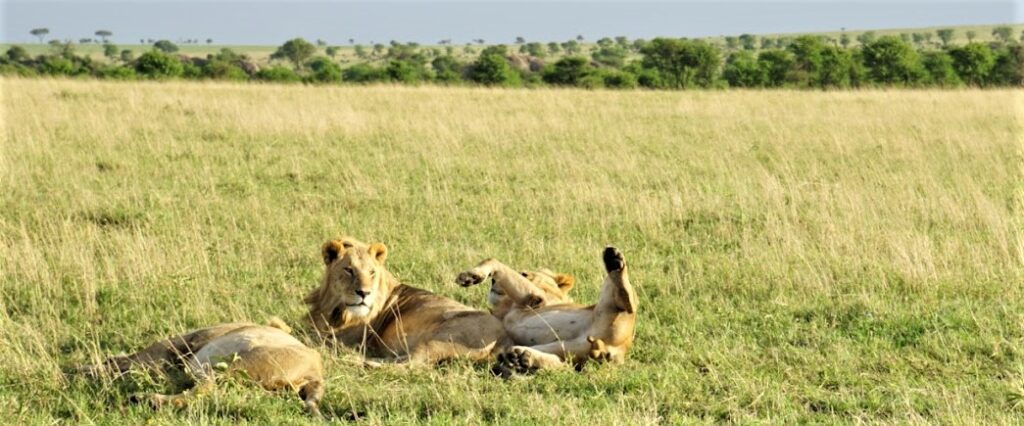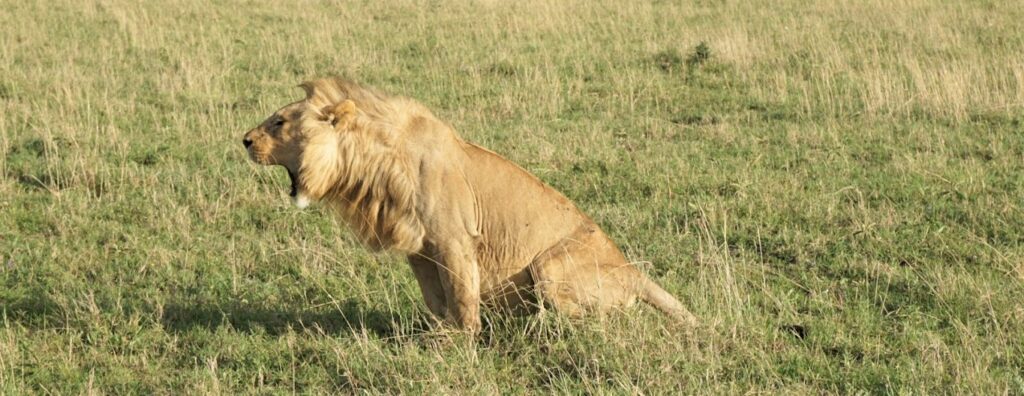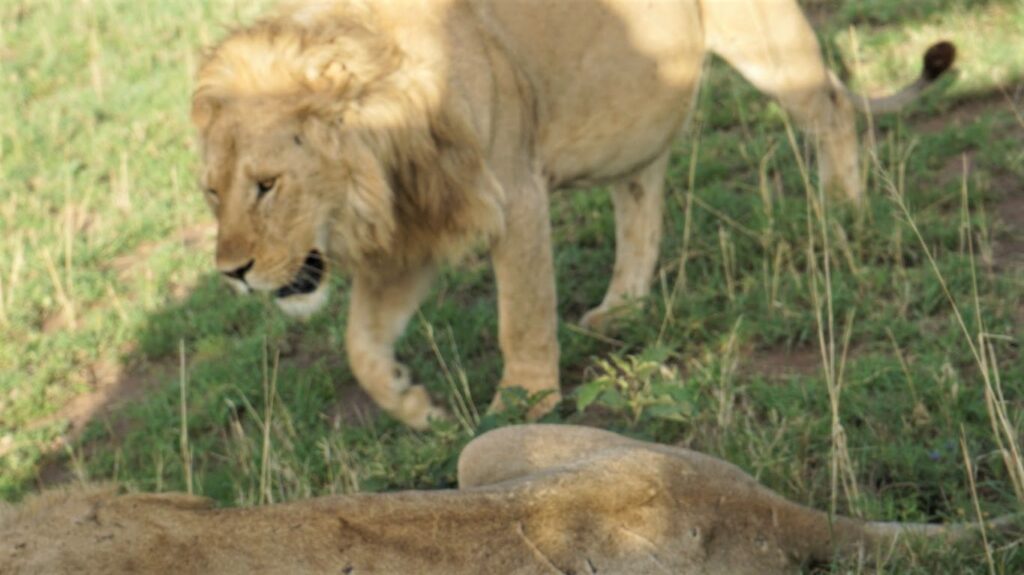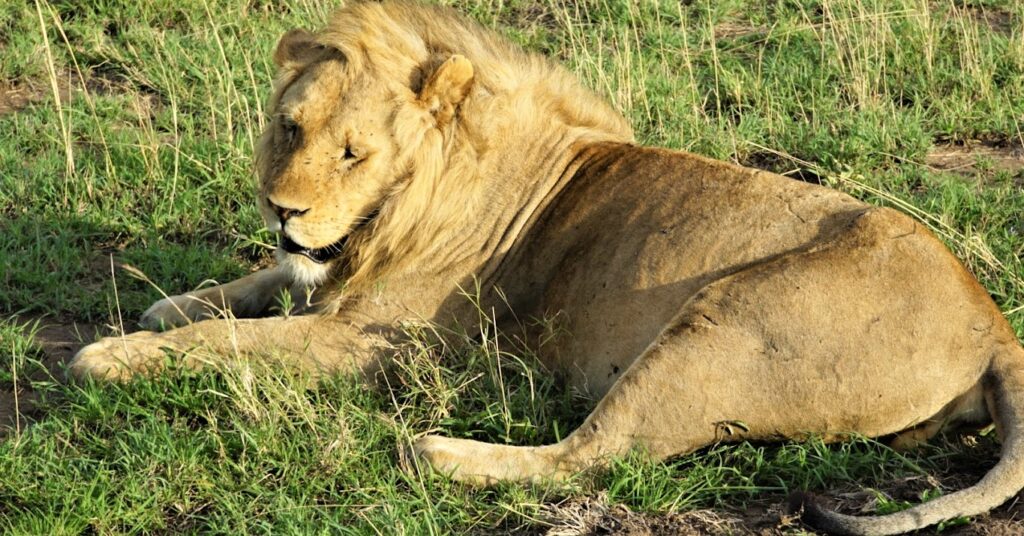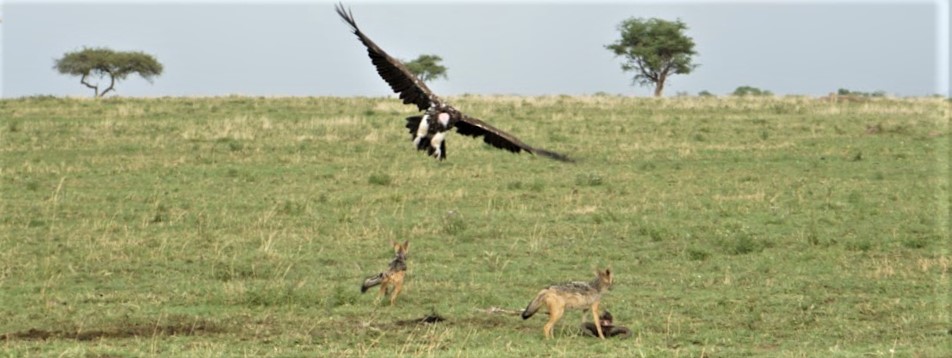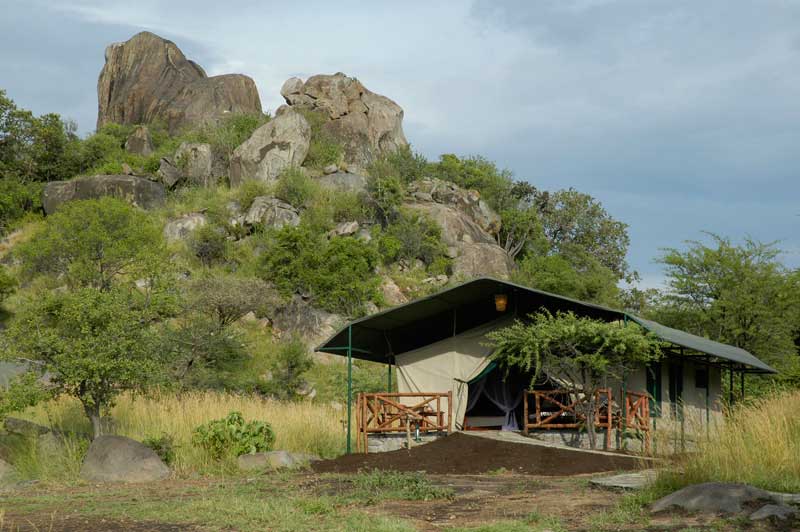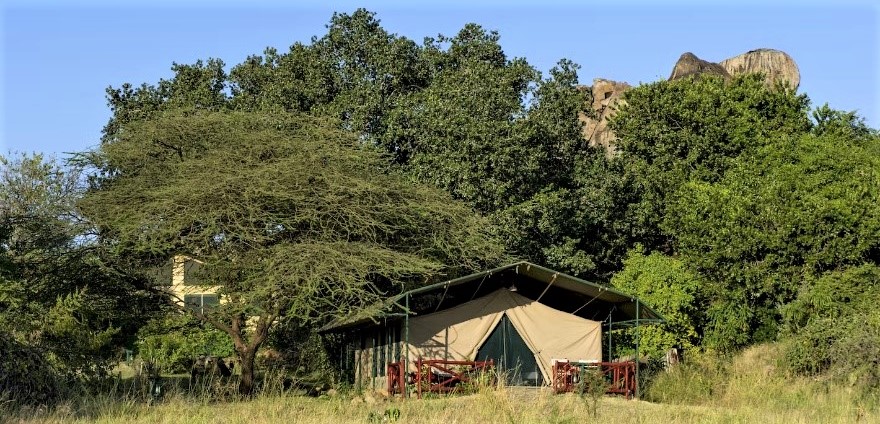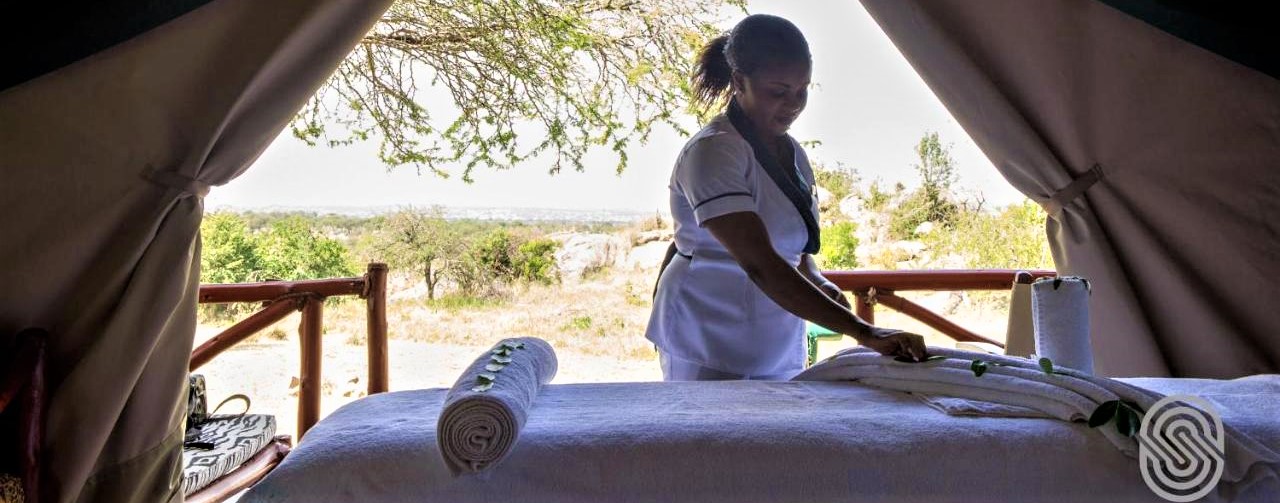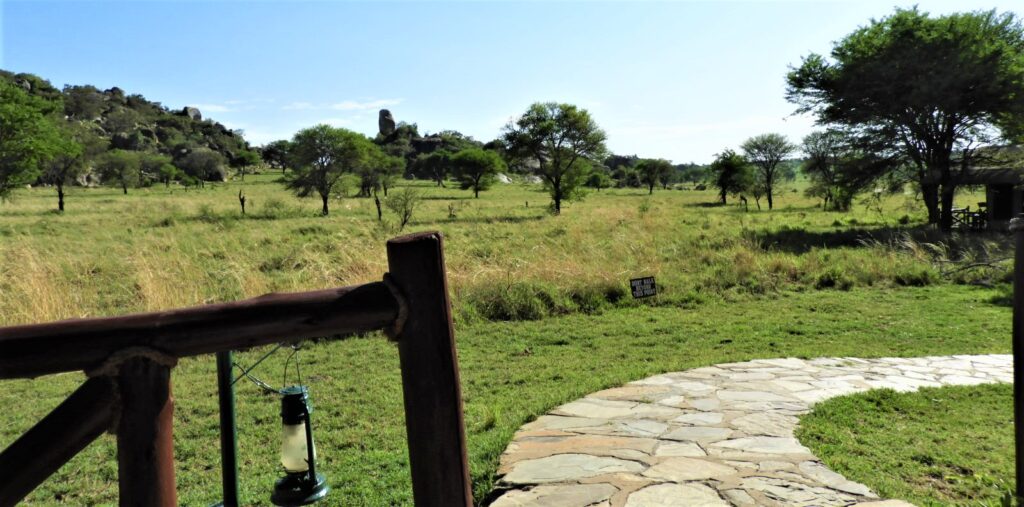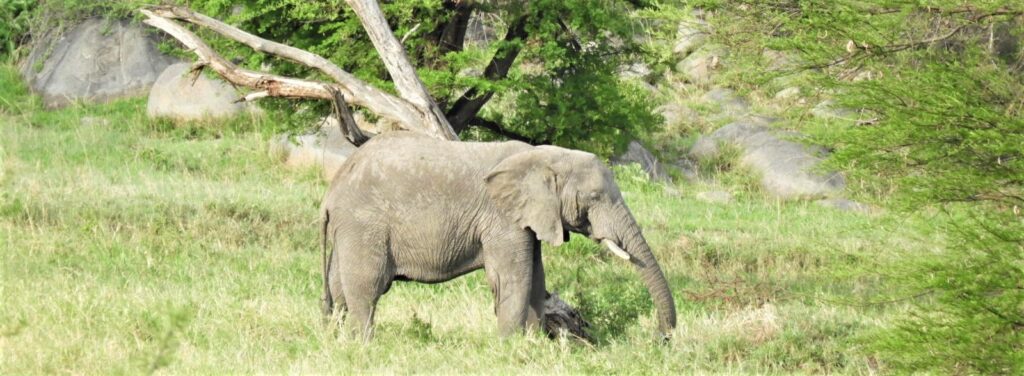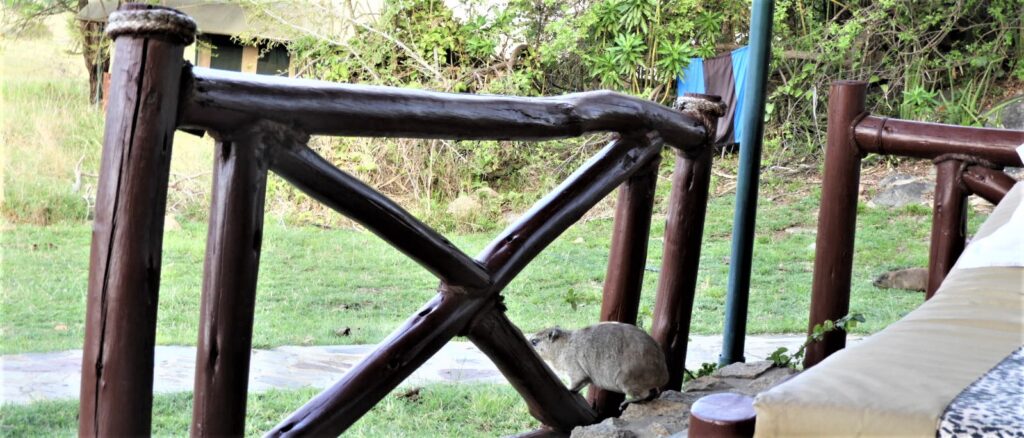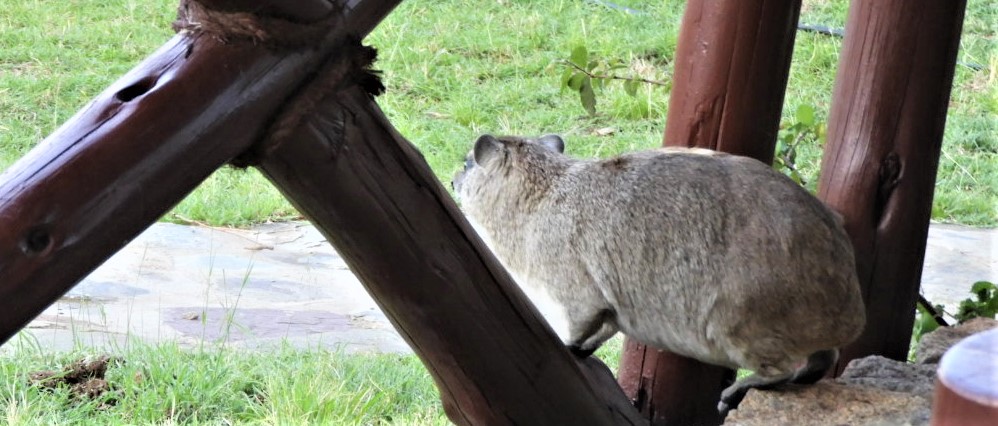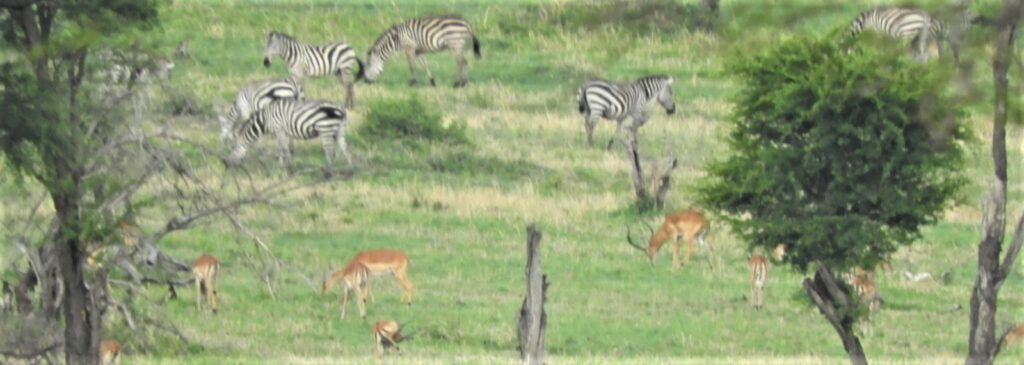» September 26th, 2022
To Market, To Market
Linda Lou Burton posting from Zanzibar Serena Hotel, Stone Town, Zanzibar, Tanzania –  A fat pig is about the only thing I didn’t see in Darajani Market this morning. Zanzibar is 99% Muslim, and since pork isn’t an approved dietary item in the Islamic religion, you wouldn’t expect to see it in local stores, or on restaurant menus. Beef, chicken, and goat are on the approved list, as well as seafood; so in a country right on the ocean’s coastline, it makes sense that the Fish Market was the first spot I caught a whiff of. The “morning catch”? I’d watched the fishing boats from my porch at
A fat pig is about the only thing I didn’t see in Darajani Market this morning. Zanzibar is 99% Muslim, and since pork isn’t an approved dietary item in the Islamic religion, you wouldn’t expect to see it in local stores, or on restaurant menus. Beef, chicken, and goat are on the approved list, as well as seafood; so in a country right on the ocean’s coastline, it makes sense that the Fish Market was the first spot I caught a whiff of. The “morning catch”? I’d watched the fishing boats from my porch at 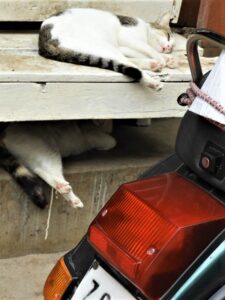 dawn, cruising slowly by, voices likely discussing the catch (good, or bad); is that what I saw in the pile just inside the fishy-smelling building? The market is (understandably) a paradise for cats; as I walked along I spotted cats everywhere; licking their paws, taking a snooze, their little sniffers dreaming sweet, sweet dreams.
dawn, cruising slowly by, voices likely discussing the catch (good, or bad); is that what I saw in the pile just inside the fishy-smelling building? The market is (understandably) a paradise for cats; as I walked along I spotted cats everywhere; licking their paws, taking a snooze, their little sniffers dreaming sweet, sweet dreams.
 I was headed for the Zanzibar Coffee House. Tour Guide Said worked it out with Ali, our driver, to get me as close as possible about the time he and Rick would arrive on the Walking Tour. The “closest” was a 10-minute walk for me (slowly, slowly, pole, pole) through the swirling noise and smells and color where everything was for sale but pig. Spice Island spices, yes. Octopus, changu (a favorite fish), chicken, piles of seafood; bananas, oranges, avocado, pineapple. Shoes. Electronics. What fascinated me most? We’d seen piles of produce and clothing and other tradeable items at markets all the way through Kenya and Tanzania, so crowds and color were not unusual to my eyes. Here though, everything was compressed; tucked into the narrowest of spaces, which seemed to magnify the scene. A dazzling mixture of Arab, Persian, Indian, European and African styles and traditions! Stone Town’s cast of characters is better than a Hollywood movie set. Action! Camera!
I was headed for the Zanzibar Coffee House. Tour Guide Said worked it out with Ali, our driver, to get me as close as possible about the time he and Rick would arrive on the Walking Tour. The “closest” was a 10-minute walk for me (slowly, slowly, pole, pole) through the swirling noise and smells and color where everything was for sale but pig. Spice Island spices, yes. Octopus, changu (a favorite fish), chicken, piles of seafood; bananas, oranges, avocado, pineapple. Shoes. Electronics. What fascinated me most? We’d seen piles of produce and clothing and other tradeable items at markets all the way through Kenya and Tanzania, so crowds and color were not unusual to my eyes. Here though, everything was compressed; tucked into the narrowest of spaces, which seemed to magnify the scene. A dazzling mixture of Arab, Persian, Indian, European and African styles and traditions! Stone Town’s cast of characters is better than a Hollywood movie set. Action! Camera!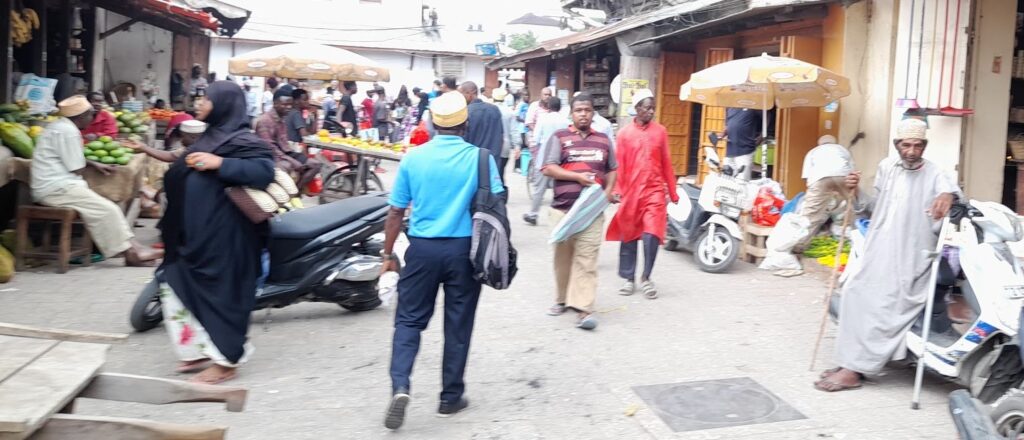
Some things to get a picture of: traditional buildings have a baraza, a long stone bench for resting or socializing along the outside walls; it’s an elevated sidewalk if it rains too much. Most buildings have large verandas (look up) protected by carved wooden balustrades. The  town is a maze of narrow alleys and most streets are too narrow for cars, so it’s crowded with bicycles and motorbikes. Darajani Market, which has been around since 1904, is on the edge of Stone Town, extending to the wider street along the seafront. Another interesting market – actually a giant open-air restaurant
town is a maze of narrow alleys and most streets are too narrow for cars, so it’s crowded with bicycles and motorbikes. Darajani Market, which has been around since 1904, is on the edge of Stone Town, extending to the wider street along the seafront. Another interesting market – actually a giant open-air restaurant 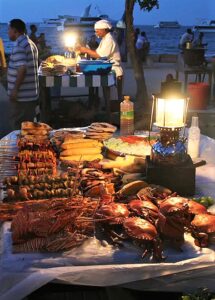 – is in Forodhani Park, right on the waterfront. Every night food stalls set up there to serve every kind of seafood you can imagine; people come in droves (locals and tourists alike); hey, Anthony Bourdain did a feature on it; he had octopus! Did I get my Zanzibarian coffee today? I did indeed, in an authentic Arabic house constructed in 1885 by Sir Tharia Topan, Wazir to Sultan Said Barghash. A wazir is an aide, or minister, by the way. More on sultans coming up.
– is in Forodhani Park, right on the waterfront. Every night food stalls set up there to serve every kind of seafood you can imagine; people come in droves (locals and tourists alike); hey, Anthony Bourdain did a feature on it; he had octopus! Did I get my Zanzibarian coffee today? I did indeed, in an authentic Arabic house constructed in 1885 by Sir Tharia Topan, Wazir to Sultan Said Barghash. A wazir is an aide, or minister, by the way. More on sultans coming up.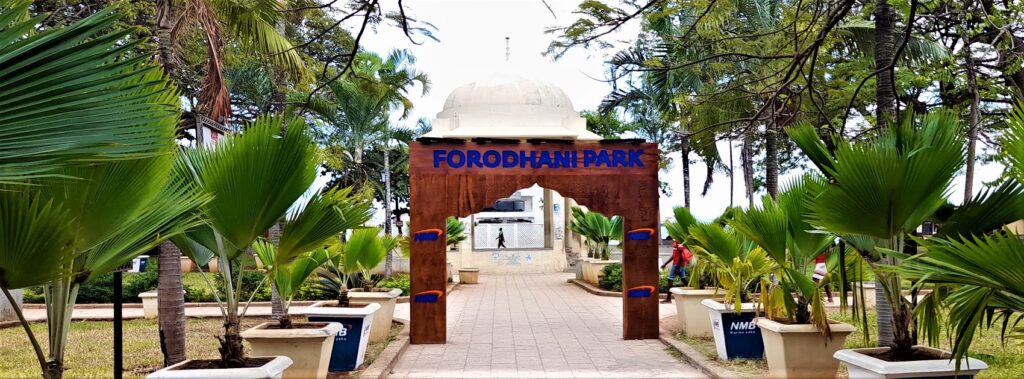
Can you find our guide Said? He’s wearing the gold hat (kufi) and the blue shirt.
“To Market, To Market” is a folk nursery rhyme based upon the traditional rural activity of going to a market where agricultural products would be bought and sold. Typically chanted when bouncing baby on your knee, it came to mind while I was walking “the market” today.
- To market, to market, to buy a fat pig,
- Home again, home again, jiggety-jig.
- To market, to market, to buy a fat hog,
- Home again, home again, jiggety-jog.
- To market, to market to buy a plum cake,
- Home again, home again, market is late.
- To market, to market, to buy a plum bun,
- Home again, home again, market is done.
Zanzibar Serena Hotel https://www.serenahotels.com/zanzibar
Zanzibar Coffee House https://www.utengule.com/zanzibar-coffee-house
Fisherman’s Tours https://fishermantours.com/
Next Post: Sultans and Slavers
» September 26th, 2022
Freddie & The Doors
Linda Lou Burton posting from Zanzibar Serena Hotel, Stone Town, Zanzibar, Tanzania –  Is this going to be a post about rock stars? Well yes, and no. Those of a certain generation might think “rock stars” when you see The Doors; likewise when you see the name Freddie. Freddie Mercury. Queen. The Doors. They were the noise of the 60s, and onward; controversial and influential, changing music and leaving behind songs that stick with us to this day. And they were flamboyant! So it was a bit of a surprise to realize our hotel was just around the corner from the Freddie Mercury museum in Stone Town, Zanzibar, a city steeped in traditions that go back to Medieval times. Freddie didn’t BECOME a rock star in this setting, but he was BORN in Stone Town on September 5, 1946, as Farrokh Bulsara to
Is this going to be a post about rock stars? Well yes, and no. Those of a certain generation might think “rock stars” when you see The Doors; likewise when you see the name Freddie. Freddie Mercury. Queen. The Doors. They were the noise of the 60s, and onward; controversial and influential, changing music and leaving behind songs that stick with us to this day. And they were flamboyant! So it was a bit of a surprise to realize our hotel was just around the corner from the Freddie Mercury museum in Stone Town, Zanzibar, a city steeped in traditions that go back to Medieval times. Freddie didn’t BECOME a rock star in this setting, but he was BORN in Stone Town on September 5, 1946, as Farrokh Bulsara to  Indian-born parents Bomi and Jer Bulsara. Bomi was a cashier at the British Colonial Office in Stone Town; Zanzibar was a British Protectorate at the time. Farrokh spent most of his school years in India, coming back to Zanzibar in 1963 to be with his parents; but in spring of 1964 the family fled to England to escape the violence of the revolution against the Sultan of Zanzibar and the mainly Arab government. Farrokh changed his name to Freddie Mercury in England and you know the rest of that story. (Or not.) The Museum was opened in Zanzibar November 24, 2019, commemorating the 28th anniversary of Freddie’s death.
Indian-born parents Bomi and Jer Bulsara. Bomi was a cashier at the British Colonial Office in Stone Town; Zanzibar was a British Protectorate at the time. Farrokh spent most of his school years in India, coming back to Zanzibar in 1963 to be with his parents; but in spring of 1964 the family fled to England to escape the violence of the revolution against the Sultan of Zanzibar and the mainly Arab government. Farrokh changed his name to Freddie Mercury in England and you know the rest of that story. (Or not.) The Museum was opened in Zanzibar November 24, 2019, commemorating the 28th anniversary of Freddie’s death.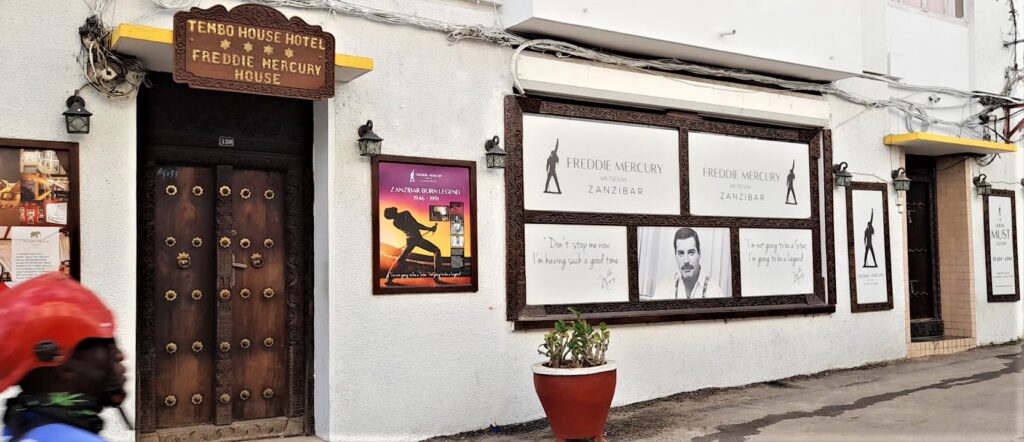
“We can walk there together later on our own,” we agreed this morning as Rick headed out to begin his organized City Walking Tour. Well, we didn’t. But Rick walked past it on his tour, and I rode past it in the tour van later. Ha! At least we both saw the beautiful DOOR out front.
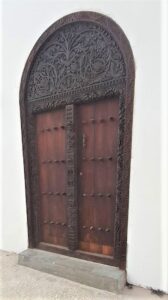 NOW TO THE DOORS: Zanzibar is FAMOUS for its DOORS! As it should be; they are elegant, intricate, beautiful, and long-lasting bits of “history we like to look at.” Fortunately, craftsmen and artists and entrepreneurs will make one for you in this day and time, for a price of course. Rick and I were just intent on looking AT them today, and thinking about events that took place on either side of them. What stories they could tell! The buildings in Stone Town are old; the streets and alleyways are narrow and crowded. We both took photos; of doors surrounded by people, cats, cars, life in a hurry or life over a cup of coffee. I give you a few descriptive bits (don’t get bored) about the meaning of the designs, see what you can pick out on the photos of the doors we saw. How old would you guess each door to be? Consider this:
NOW TO THE DOORS: Zanzibar is FAMOUS for its DOORS! As it should be; they are elegant, intricate, beautiful, and long-lasting bits of “history we like to look at.” Fortunately, craftsmen and artists and entrepreneurs will make one for you in this day and time, for a price of course. Rick and I were just intent on looking AT them today, and thinking about events that took place on either side of them. What stories they could tell! The buildings in Stone Town are old; the streets and alleyways are narrow and crowded. We both took photos; of doors surrounded by people, cats, cars, life in a hurry or life over a cup of coffee. I give you a few descriptive bits (don’t get bored) about the meaning of the designs, see what you can pick out on the photos of the doors we saw. How old would you guess each door to be? Consider this:
- The Swahili or Zanzibari doors were developed during the Middle Ages.
- The oldest are found along the East African coast from Mozambique to Kenya.
- The highest concentration of remaining doors is in Zanzibar’s Stone Town.
- They were created for the wealthy: sultans and slave traders and caravan traders.
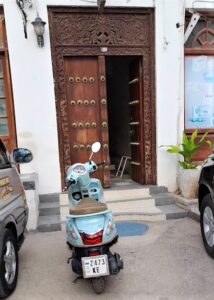 The Swahili designs are divided into two types; the classic rectangular is more geometric with more pre-Islamic forms; with motifs of lotus, rosettes, chain, date palms, and fish. Later designs changed to arched lintels; these doors have more floral patterns due to Indian inspiration as more Indian immigrants came to East Africa. The chain was replaced with beads on the frame; the fish became a vase with vines. The center of the lintel in both the rectangular and arched style usually has an Arabic inscription – a quote from the Koran, the date of completion of the door, or the owner’s initial and/or name. The doors themselves are not carved, instead, they are studded with metal tiers usually made of Brass or cast iron. The wood used for the most expensive doors is African ebony or imported teak.
The Swahili designs are divided into two types; the classic rectangular is more geometric with more pre-Islamic forms; with motifs of lotus, rosettes, chain, date palms, and fish. Later designs changed to arched lintels; these doors have more floral patterns due to Indian inspiration as more Indian immigrants came to East Africa. The chain was replaced with beads on the frame; the fish became a vase with vines. The center of the lintel in both the rectangular and arched style usually has an Arabic inscription – a quote from the Koran, the date of completion of the door, or the owner’s initial and/or name. The doors themselves are not carved, instead, they are studded with metal tiers usually made of Brass or cast iron. The wood used for the most expensive doors is African ebony or imported teak.
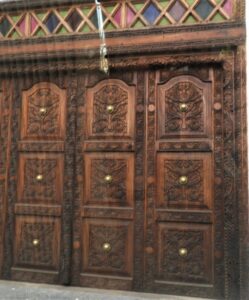
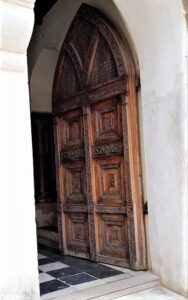
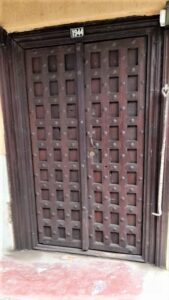

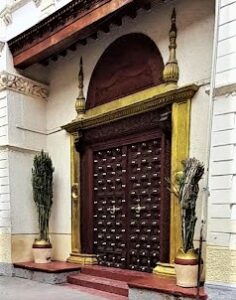
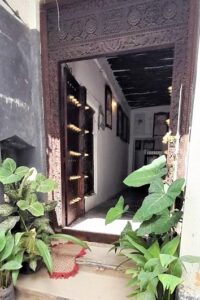
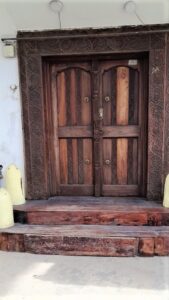
Zanzibar Serena Hotel https://www.serenahotels.com/zanzibar
Fisherman’s Tours https://fishermantours.com/
Freddie Mercury Museum https://freddiemercurymuseum.com/
Next Post: To Market, To Market
» September 25th, 2022
The Pause Button
Linda Lou Burton posting from Zanzibar Serena Hotel, Stone Town, Zanzibar, Tanzania – 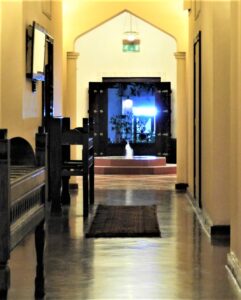 The telephone was ringing. I left my peaceful spot on the porch, wondering who would be calling so early on a Sunday morning. It was the front desk. “Your Tour Guide is in the lobby,” I was informed. Still in my jammies, I hastily threw on yesterday’s clothes, grabbed all the Globus info, and headed down the hall. A smiling man wearing a Fisherman’s Tours badge, said “Good morning, Madame. I am Said, and I have come to take you on the Walking Tour of the city.” I shook my head and began my apology. “I am so sorry! I guess the message didn’t get through. I told our Transport Driver yesterday we wanted to have a day of rest and do our tours tomorrow. I am very sorry for the inconvenience. We are just too tired to do anything today! Plus, we want to change the tours that were picked for us. I can’t do the walking City
The telephone was ringing. I left my peaceful spot on the porch, wondering who would be calling so early on a Sunday morning. It was the front desk. “Your Tour Guide is in the lobby,” I was informed. Still in my jammies, I hastily threw on yesterday’s clothes, grabbed all the Globus info, and headed down the hall. A smiling man wearing a Fisherman’s Tours badge, said “Good morning, Madame. I am Said, and I have come to take you on the Walking Tour of the city.” I shook my head and began my apology. “I am so sorry! I guess the message didn’t get through. I told our Transport Driver yesterday we wanted to have a day of rest and do our tours tomorrow. I am very sorry for the inconvenience. We are just too tired to do anything today! Plus, we want to change the tours that were picked for us. I can’t do the walking City  Tour, and we both want to go to a Spice Farm instead of walking in the Jozani Forest as you have scheduled, but we need to do that tomorrow. Can we please arrange that? I talked to the Globus main office about these changes months ago, but they told me I’d need to work with you directly once I got here.” Said was most agreeable and kind, as I kept apologizing for his troubles. We agreed on 9 AM tomorrow for Rick to do the Walking Tour of the City, with the driver getting me to one of the places I wanted to visit, the Zanzibar Coffee House. Then lunch, and an afternoon tour of a spice farm, which would take us farther inland on the island. We said our farewells, “Until tomorrow, then.”
Tour, and we both want to go to a Spice Farm instead of walking in the Jozani Forest as you have scheduled, but we need to do that tomorrow. Can we please arrange that? I talked to the Globus main office about these changes months ago, but they told me I’d need to work with you directly once I got here.” Said was most agreeable and kind, as I kept apologizing for his troubles. We agreed on 9 AM tomorrow for Rick to do the Walking Tour of the City, with the driver getting me to one of the places I wanted to visit, the Zanzibar Coffee House. Then lunch, and an afternoon tour of a spice farm, which would take us farther inland on the island. We said our farewells, “Until tomorrow, then.”
Rick was still sitting on the porch when I returned. “A whole day of nothing planned!” I said. “For the first time in sixteen days, we can do just what we want to do, when we want to do it. And that includes doing nothing.” “Sounds like a plan to me!” he replied. Here’s what we did.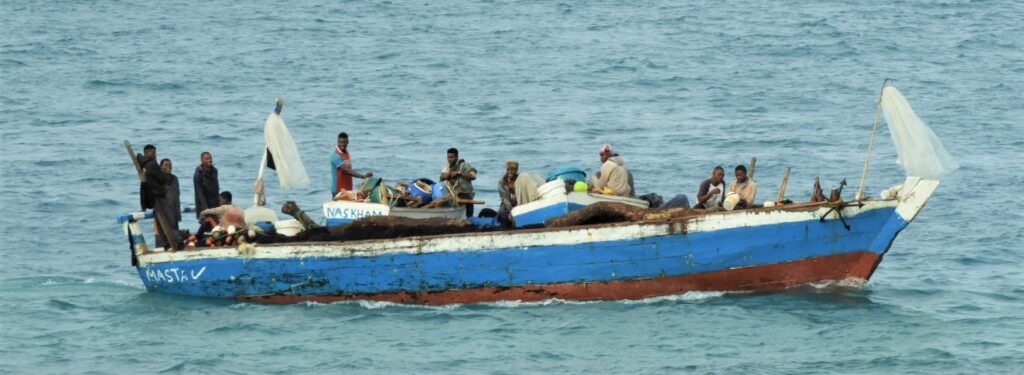
- Watched the boats go by.
- Watched the tide go out.
- Watched people walking on the beach.
- Watched people pretending to swim in the ocean.
- Watched the tide come in.
- Wandered around our pool.
- Wandered the hotel grounds.
- Ate lunch in the Baharia Restaurant with open-air windows overlooking the beach.
- Took pictures of the flowers.
- Took pictures of the people. (And yes, the gal in the scruffy jeans shorts is the one in the teeny-weeny bikini, surprise!)
It’s hard to do ABSOLUTELY nothing. As our gang-mate Ed said often, while we were on safari, “There’s always something to look at.” Even when you hit the pause button.
Zanzibar Serena Hotel https://www.serenahotels.com/zanzibar
Fisherman’s Tours https://fishermantours.com/
Next Post: Freddie & The Doors
» September 24th, 2022
Well, There It Is
Linda Lou Burton posting from Zanzibar Serena Hotel, Stone Town, Zanzibar, Tanzania – I’m not just looking at the Indian Ocean right now. I am smelling it, hearing it, and within  inches of touching it. Which happens to be the next part of my plan. You see, there are five oceans in the world, and they cover 70% of the Earth’s surface. So if you plan to See The World, you’re going to have to swim, cruise, or fly over a lot of water! And naturally, you’ll want to get your foot in it. I may have come in contact with Atlantic waters when I was 5 and Dad and Mom took me swimming in Virginia’s York River. But that’s a stretch, although salt water does come inland that far. Certainly during the 60s and 70s I spent time on the Atlantic seaboard with my kids, wading and splashing from Florida all the way to Maine. In 1978 my sons and I went plowing into the Pacific waters at Santa Monica Beach, after a long drive cross-country to California. Then I had 25 years of living on the West Coast and enjoying the Pacific waters from California to Washington state. It was 2005 when I did the quirky thing of going NORTH of the Artic Circle and SOUTH of
inches of touching it. Which happens to be the next part of my plan. You see, there are five oceans in the world, and they cover 70% of the Earth’s surface. So if you plan to See The World, you’re going to have to swim, cruise, or fly over a lot of water! And naturally, you’ll want to get your foot in it. I may have come in contact with Atlantic waters when I was 5 and Dad and Mom took me swimming in Virginia’s York River. But that’s a stretch, although salt water does come inland that far. Certainly during the 60s and 70s I spent time on the Atlantic seaboard with my kids, wading and splashing from Florida all the way to Maine. In 1978 my sons and I went plowing into the Pacific waters at Santa Monica Beach, after a long drive cross-country to California. Then I had 25 years of living on the West Coast and enjoying the Pacific waters from California to Washington state. It was 2005 when I did the quirky thing of going NORTH of the Artic Circle and SOUTH of 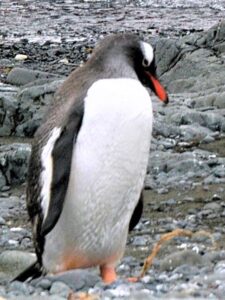 the Antarctic on the first day of summer at each. So, June 2005 I put a boot into the Arctic Ocean, and December 2005, a boot into the Southern Ocean. Yes, for both of those, I was surrounded by snow; a guide had his rifle ready on Artic Ocean day and barely agreed to let me out of the Hummer. “If a polar bear is coming, I can’t see him until he’s close,” he warned. In Antarctica, the penguins were much less a threat; the idea there was to protect THEM from US; my boots were sanitized before going ashore. It’s 2022 now, and here I am, FINALLY, at Ocean #5 – there it is – the bluest, warmest, and 3rd largest ocean in the world. Pardon me while I sit on my porch just 20 feet away from it. I’ll do the touching thing tomorrow, but right now I’m going to look at it until it’s pitch plum dark. Room service, please?
the Antarctic on the first day of summer at each. So, June 2005 I put a boot into the Arctic Ocean, and December 2005, a boot into the Southern Ocean. Yes, for both of those, I was surrounded by snow; a guide had his rifle ready on Artic Ocean day and barely agreed to let me out of the Hummer. “If a polar bear is coming, I can’t see him until he’s close,” he warned. In Antarctica, the penguins were much less a threat; the idea there was to protect THEM from US; my boots were sanitized before going ashore. It’s 2022 now, and here I am, FINALLY, at Ocean #5 – there it is – the bluest, warmest, and 3rd largest ocean in the world. Pardon me while I sit on my porch just 20 feet away from it. I’ll do the touching thing tomorrow, but right now I’m going to look at it until it’s pitch plum dark. Room service, please?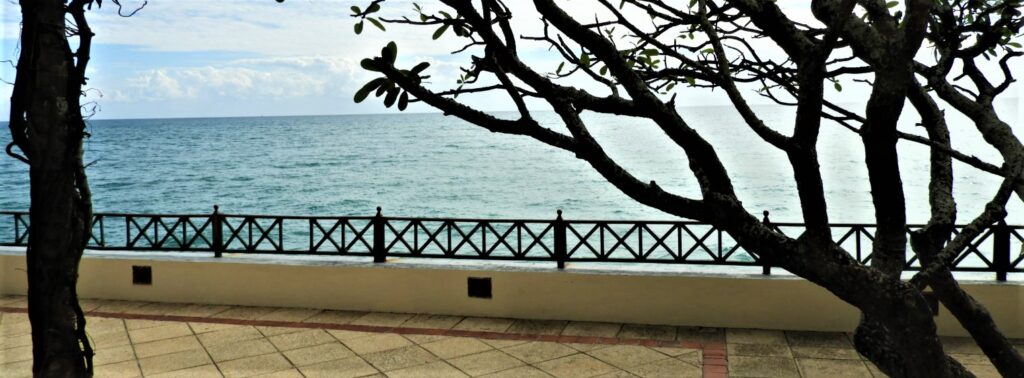
Know Your Oceans
- Pacific Ocean: 104,800,000 sq miles between Asia and Australasia and the Americas.
- Atlantic Ocean: 52,899,000 sq miles between the Americas and Europe and Africa.
- Indian Ocean: 43,844,000 sq miles between southern Asia, Africa and Australia.
- Southern Ocean: 13,645,000 sq miles between Antarctica and the Pacific, Atlantic and Indian oceans.
- Arctic Ocean: 9,667,000 sq miles between northern North America and Eurasia in the Arctic.
Zanzibar Serena Hotel https://www.serenahotels.com/zanzibar
Next Post: The Pause Button
» September 24th, 2022
A Story of Water
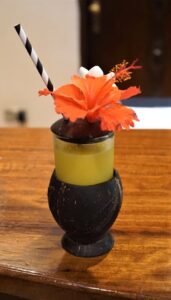 Linda Lou Burton posting from Zanzibar Serena Hotel, Stone Town, Zanzibar, Tanzania – This is the prettiest drink ever! And I promise, the most welcomed. We arrived at our exotic Serena-By-The-Sea (Kingdom by the sea? Poe) just after 3 PM, with a poet’s bag of stories (I shall be telling this with a sigh, somewhere ages and ages hence.” Frost). There’s the story of Ben’s flight-booking surprise, that turned into turmoil for everyone. There’s the story of our strange pilot (Santa?) who “spoke not a word but went straight to his work” for the entire two-hour flight. There’s the story of Immigrations (Give me your tired… Lazarus) where, even though Zanzibar is IN Tanzania, and we were IN Tanzania on a Tanzanian visa as evidenced in our passports, we had to fill out paperwork for Zanzibar. And then there’s the story of water.
Linda Lou Burton posting from Zanzibar Serena Hotel, Stone Town, Zanzibar, Tanzania – This is the prettiest drink ever! And I promise, the most welcomed. We arrived at our exotic Serena-By-The-Sea (Kingdom by the sea? Poe) just after 3 PM, with a poet’s bag of stories (I shall be telling this with a sigh, somewhere ages and ages hence.” Frost). There’s the story of Ben’s flight-booking surprise, that turned into turmoil for everyone. There’s the story of our strange pilot (Santa?) who “spoke not a word but went straight to his work” for the entire two-hour flight. There’s the story of Immigrations (Give me your tired… Lazarus) where, even though Zanzibar is IN Tanzania, and we were IN Tanzania on a Tanzanian visa as evidenced in our passports, we had to fill out paperwork for Zanzibar. And then there’s the story of water.
I was the last person on the plane (slowly, slowly; pole, pole) being pushed and pulled up the tiny steps and squeezed into the last seat. The person carrying my backpack threw it into the pile of luggage secured behind a cloth curtain at the back. As the plane taxied down the runway, my seatmate began recording our flight, his camera-on-a-stick held to the window, technology capturing his dull monotone voice. I looked around, surveying my surroundings; the plane had 1-2 seating with me in the aisle seat. Friedrich (I decided to name him) was on my right and his traveling partner Frieda (as I named her) had the single window seat to the left of me (yes, they had grabbed both windows). About 30 minutes into the flight, Friedrich reached into his backpack and pulled out two water bottles. He leaned over me and handed one across the aisle to Frieda, then tucked one into his seat pocket, unopened. This set off the “thirst command” in my head, and I realized that MY water bottle was in my backpack, and my backpack was way beyond my reach, oh criminy! After 30 minutes of staring at those two unopened water bottles, I nudged Friedrich’s arm and said, in gesturing English, “I need some water badly but mine is in the back. I’ll be glad to pay you for your water bottle.” He shook his head and frowned. “No. This is my water.” Then I started coughing. I didn’t MEAN to, I swear! But I couldn’t stop coughing! My mouth was completely dry; I was reminded of those poor zebras in Amboseli, dying of thirst. My throat hurt. I was thinking evil thoughts. Friedrich never looked my way, nor did he ever open his water bottle. Frieda didn’t either.
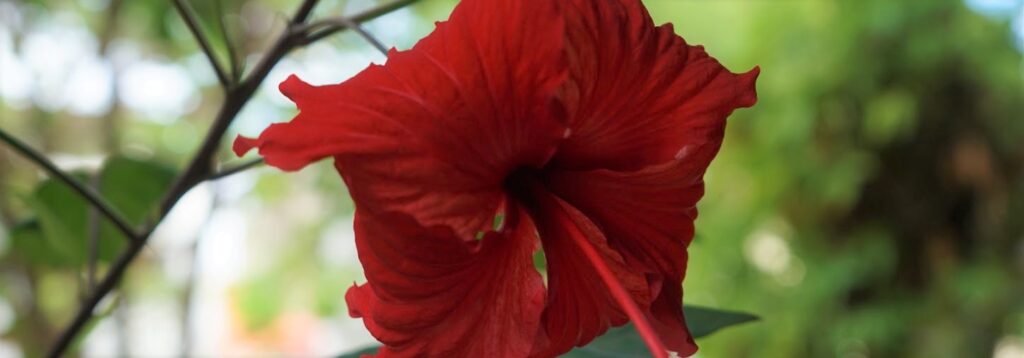 This beautiful drink I’m sipping now, in the lobby of my Serena-by-the-Indian Ocean, isn’t the much-craved water I needed so badly on the plane, but bungo juice, which is found only in Zanzibar; it tastes of pineapple, mango, and orange; refreshing but not too sweet. The flower is hibiscus; red and orange blooms surround the hotel. A poet would have a word for a place like this, I’m thinking, as I looked past the massive hand-carved doors to the lively street scene out front. “Friedrich and Frieda will probably hate it here” is the best line I’ve got.
This beautiful drink I’m sipping now, in the lobby of my Serena-by-the-Indian Ocean, isn’t the much-craved water I needed so badly on the plane, but bungo juice, which is found only in Zanzibar; it tastes of pineapple, mango, and orange; refreshing but not too sweet. The flower is hibiscus; red and orange blooms surround the hotel. A poet would have a word for a place like this, I’m thinking, as I looked past the massive hand-carved doors to the lively street scene out front. “Friedrich and Frieda will probably hate it here” is the best line I’ve got.
A record of our day, so far, beginning at Seronera Airstrip. See, I had water with me!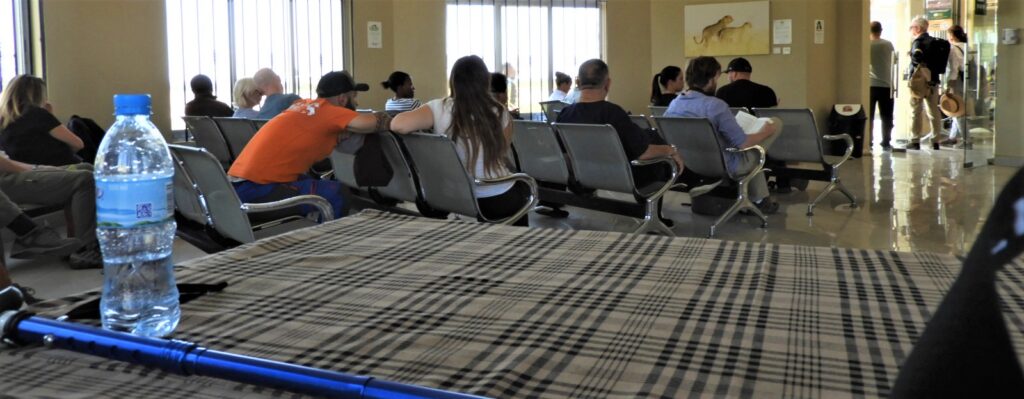
Zanzibar Serena Hotel https://www.serenahotels.com/zanzibar
» September 24th, 2022
Even Safaris End
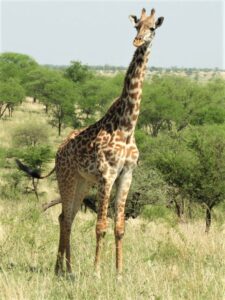 Linda Lou Burton posting from Seronera Airstrip, Serengeti National Park, Tanzania–Some things you never want to forget. I’ll remember my gripes about this fast-paced-energy-charged safari for a long time. It’s been exhausting! But I’ll remember the giraffes forever. That very first day, when I gently placed a pellet on the gray velvet tongue of a giraffe and looked straight into those eyes with their Hollywood lashes, I was forever taken in. They look amazing in the wild too; in every photo I took, zooming across the grasslands, those beautiful long lashes stand out. I’ll remember the neat-looking zebras, and their unlikely best buds, the scraggly wildebeests, what an odd, but wildly successful, relationship! I’ll remember the pudgy hippos with their sublime mudpuddle grins and the rhinos with those not very attractive outgrowths stuck to the top of their faces that make them a desirable target for mean money makers. I’ll remember the elephants, going at life full-force, pushing over trees and slinging dust every which way, but so tender hearted they grieve when they lose a loved one. I’ll remember the many species of antelope, with their dainty, pretty, sometimes
Linda Lou Burton posting from Seronera Airstrip, Serengeti National Park, Tanzania–Some things you never want to forget. I’ll remember my gripes about this fast-paced-energy-charged safari for a long time. It’s been exhausting! But I’ll remember the giraffes forever. That very first day, when I gently placed a pellet on the gray velvet tongue of a giraffe and looked straight into those eyes with their Hollywood lashes, I was forever taken in. They look amazing in the wild too; in every photo I took, zooming across the grasslands, those beautiful long lashes stand out. I’ll remember the neat-looking zebras, and their unlikely best buds, the scraggly wildebeests, what an odd, but wildly successful, relationship! I’ll remember the pudgy hippos with their sublime mudpuddle grins and the rhinos with those not very attractive outgrowths stuck to the top of their faces that make them a desirable target for mean money makers. I’ll remember the elephants, going at life full-force, pushing over trees and slinging dust every which way, but so tender hearted they grieve when they lose a loved one. I’ll remember the many species of antelope, with their dainty, pretty, sometimes  fairytale swirls of horns, and the big broad sweep of the buffalo’s “boss” stretching across the top of his head. I’ll remember the land plover, fearlessly guarding her two tiny eggs laying among the rocks at the side of the road. As for the lions, well sure, I know they have teeth and jaw powerful enough to bite off my arm, but what I’ll remember is all that sleeping, and stretching, and sleeping, just like my sweet little Katy cat. Overall in my memories, however, is the land, the landscape, the home for these animals. The acacia trees dotted across the open plains are planted firmly in my dreams. What a fitting place to end our safari today – the Serengeti. Even the name is beautiful – “serengeti” is an approximation of the word “siringet” used by the Maasai meaning “the place where the land runs on forever.”
fairytale swirls of horns, and the big broad sweep of the buffalo’s “boss” stretching across the top of his head. I’ll remember the land plover, fearlessly guarding her two tiny eggs laying among the rocks at the side of the road. As for the lions, well sure, I know they have teeth and jaw powerful enough to bite off my arm, but what I’ll remember is all that sleeping, and stretching, and sleeping, just like my sweet little Katy cat. Overall in my memories, however, is the land, the landscape, the home for these animals. The acacia trees dotted across the open plains are planted firmly in my dreams. What a fitting place to end our safari today – the Serengeti. Even the name is beautiful – “serengeti” is an approximation of the word “siringet” used by the Maasai meaning “the place where the land runs on forever.”
Early morning packing (don’t forget that hustle!) to taking pictures of each other, just before boarding our plane. The first animals of the day were two cape buffalo by our front porch (yes, I called security). The last animal (surprise!) was the long awaited “tree-climbing lion.” I reminded Willy of our fruitless search at Lake Manyara, saying “Willy, don’t let us leave forever without seeing a lion in a tree.” By golly, he found one. Do you see a lion in that nice shady tree? Willy did! He moved the 4×4 so we could see both back and front.
Serengeti National Park is a World Heritage Site covering 5,700 square miles of grassland plains, savanna, riverine forest, and woodlands. It lies in northwestern Tanzania, bordered to the north by Kenya, where it adjoins the Maasai Mara National Reserve. To the southeast is the Ngorongoro Conservation Area, to the southwest the Ikorongo and Grumeti Game Reserves, and to the northeast and east the Loliondo Game Control Area. This space teems with wildlife – over 2 million ungulates, 4,000 lions, 1,000 leopards, 550 cheetahs, and some 500 bird species. The Serengeti is well known for the largest annual animal migration in the world of over 1.5 million blue wildebeest and 250,000 zebra along with smaller herds of Thomas’ Gazelle and eland. The Park is also home to the largest lion population in Africa.
The park is divided into three regions:
- Serengeti plains: The best-known feature of the Serengeti is the almost treeless grassland in the south. It has kopjes, granite formations that serve as observation posts for predators.
- Western corridor: The Grumeti and Mbalageti. Rivers, big groups of riverine forest, and small mountain ranges stretch to Lake Victoria. The great migration passes through the corridor from May to July.
- Northern Serengeti: This remote and relatively inaccessible area is dominated by open woodlands and hills, ranging from Seronera in the south to the Mara River on the Kenyan border.
Human habitation is forbidden in the Park except for the Tanzania National Parks Authority staff, researchers and staff of the various lodges, campsites, and hotels. The main settlement is Seronera with its primary airstrip.
Serengeti National Park https://www.serengeti.com/
Next Post: A Story Of Water
» September 24th, 2022
Crossing My Fingers
Linda Lou Burton posting from Seronera Airstrip, Serengeti National Park, Tanzania– “He never helped with pictures.” This was the complaint every member of the gang was voicing, as we sat in the airstrip terminal this morning. Ben (remember, not his real name) was running here and there, supposedly getting tickets, supposedly for the right people, going to the right places. I sat terrorized, my confidence level in the “right thing” being done for the “right time” at a good minus-ten. (That’s -10.) Fond memories of Abdi, our guide in Kenya, and our 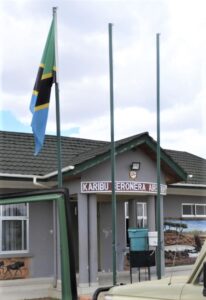 drivers in both countries (Daniel and Willy for our 4×4), all expert photographers, were recalled; how they’d take any one of our cameras (if asked, and sometimes, even if not); make the correct adjustments for the circumstances, and “get the shot.” Anyone on the wrong side of the 4×4, no matter, they were always willing to take our camera and help. Ben (remember, working on his Masters in Tourism) had his own fancy-schmancy camera with lens that could zoom to the moon, and he concentrated on his own photos at every stop. He said he was “collecting information” for a project. I wasn’t as bothered by THAT as much as his inability to get us anywhere on time, to listen to anything we might ask, and, most especially, to follow through on the trip itinerary. Promises by Globus, not carried out by Ben. Here are two:
drivers in both countries (Daniel and Willy for our 4×4), all expert photographers, were recalled; how they’d take any one of our cameras (if asked, and sometimes, even if not); make the correct adjustments for the circumstances, and “get the shot.” Anyone on the wrong side of the 4×4, no matter, they were always willing to take our camera and help. Ben (remember, working on his Masters in Tourism) had his own fancy-schmancy camera with lens that could zoom to the moon, and he concentrated on his own photos at every stop. He said he was “collecting information” for a project. I wasn’t as bothered by THAT as much as his inability to get us anywhere on time, to listen to anything we might ask, and, most especially, to follow through on the trip itinerary. Promises by Globus, not carried out by Ben. Here are two:
DAY 12, WEDNESDAY SEPTEMBER 21, 2022. NGORONGORO. Full-day game drive in the crater includes a picnic lunch. (Remember the 4:30 AM departure and boiled-egg in a box?)
DAY 14, FRIDAY SEPTEMBER 23, 2022. SERENGETI. Special farewell dinner in the bush includes a traditional Maasai dance performance. (Guess what.)
I was still stinging over his double-cross about the day in the Crater, which caused me to miss one of my prime objectives of the trip. I strongly suspect he simply failed to book the lunch in advance, and then the Lodge couldn’t accommodate us. Or maybe he thought he’d get more photos for his project earlier in the morning. I’ll never know. But the missing Maasai dance at last night’s farewell dinner was the last straw! We did have a dinner on outdoor tables, but we were seated in the dark with a spotlight in our faces (not lanterns in the trees); and the entertainment was Ben making speeches about tourism in Tanzania. Remember our “last night” with Abdi at Amboseli? Sundowners as the gang sat together around the fire, talking and reminiscing? When I asked Ben “where are our dancers?” he shrugged. “No dancers,” was all he said. I asked him to come to our tent afterwards. He did, wearing a distracted look. I put “tomorrow’s itinerary” in front of him, pointing to the arrangements, already paid for, that were critical for the next day. Rick and I were to move forward on our own, still as Globus customers, but sans a guide familiar with the territory to take care of potential goof-ups.
DAY 15, SATURDAY SEPTEMBER 24, 2022. SERENGETI–STONE TOWN, ZANZIBAR. Morning game drive. Fly (via Arusha) to Stone Town (a UNESCO World Heritage Site). STONE TOWN Free time in the late afternoon and evening.
“Do you have our plane tickets to Zanzibar?” “Do you have transport booked to get us from the airport to our hotel there?” “Is everything confirmed?” “Oh sure,” was his answer. Based on past experience, I am crossing my fingers.
Last night’s farewell dinner. A night-hunting lion strolling through, or some klipspringers dancing might have livened things up! It ended with everyone straggling off to their tent.
Mbuzi Mawe Serena Tented Camp https://www.serenahotels.com/mbuzi-mawe
Serengeti National Park https://www.serengeti.com/
Next Post: Even Safaris End
» September 24th, 2022
Let Sleeping Lions
Linda Lou Burton posting from Mbuzi Mawe Serena Tented Camp, Serengeti National Park, Tanzania–Almost time to go. Our gang disperses today. We’ve hung together, for better or worse, since Monday morning, September 12; twelve days of breathing the same air, eating the same food, and bumping our butts all day long in the same 4x4s. Some head home today. Rick and I are headed for Zanzibar, a few days added as part of the overall tour. Maureen and Ed are going to Zanzibar too, after more time in Arusha on their own. Ben and Willy head home to Arusha to begin another tour. Will the animals miss us? Gawking TOURISTS with our cameras pointing every which way at them as they try to eat, and sleep, WOW-ing  even when they fart? Yes, that was Rick’s story from yesterday’s game drive – several male lions were spotted in the grasses so of course all vehicles in the area parked within view, and every safarian raised their cameras. People in the States WARNED me to “Be careful in Africa, those lions will eat you up!” These lions, however, simply noted that the 4×4 created some shade, so walked over to begin napping in the SHADE for a while. One lion was so contented, he rolled over and farted, the sound reverberating through the 4×4; then nodded off to sleep again. I guess that’s telling them, Leo! I share Rick’s photos of the Lazy Lions, plus more lions and a few other good shots he got yesterday, like the striking kopjes he saw near a museum, while I was sitting on the porch gazing at our camp kopjes.
even when they fart? Yes, that was Rick’s story from yesterday’s game drive – several male lions were spotted in the grasses so of course all vehicles in the area parked within view, and every safarian raised their cameras. People in the States WARNED me to “Be careful in Africa, those lions will eat you up!” These lions, however, simply noted that the 4×4 created some shade, so walked over to begin napping in the SHADE for a while. One lion was so contented, he rolled over and farted, the sound reverberating through the 4×4; then nodded off to sleep again. I guess that’s telling them, Leo! I share Rick’s photos of the Lazy Lions, plus more lions and a few other good shots he got yesterday, like the striking kopjes he saw near a museum, while I was sitting on the porch gazing at our camp kopjes.
Sorry about the last photo. Rick tells me it is a leopard, and it certainly has its spots. Don’t know why the color is off, but maybe it was excitement — the leopard sighting rounded out the Big 5 for Rick — elephant, buffalo, rhinoceros, lion, and leopard. He was elated!
Mbuzi Mawe Serena Tented Camp https://www.serenahotels.com/mbuzi-mawe
Serengeti National Park https://www.serengeti.com/
Next Post: Crossing My Fingers
» September 23rd, 2022
You’ll Never Guess
Linda Lou Burton posting from Mbuzi Mawe Serena Tented Camp, Serengeti National Park, Tanzania–Now I know about kopjes. Big rocks, jutting up in the wide-open savannah. Big rocks where lions like to nap. So I’m thinking – just how safe is my tent, really? It’s just canvas, with a zippered flap. And those kopjes aren’t only in front of my tent, they are behind it too; in fact, Mbuzi Mawe Serena Tented Camp is clustered around the base of some rather marvelous looking kopjes. A very, very long way from the Walmart, or, well, anything. Here’s an aerial view of the camp – buildings snuggled against kopjes, and then, savannah. I’m pretty sure our tent is in the middle, snuggled in the trees just right of the triangle sidewalks and facing the grasses; the large lounge and dining tents are left of the triangle.
Here’s what they say about themselves: Discover a refined retreat within the natural beauty of Serengeti National Park. Mbuzi Mawe Serena Camp’s 16 canvas tents offer spacious style and home-like comforts. Reachable by a winding stone path, our tents are dotted through the rocky glades of the camp; they stand on a stone platform. The expansive main bedroom has two queen beds, covered by mosquito nets. A seating area offers comfortable chairs and stylish lamps; unwind and read a book. The bathroom opens off the bedroom and includes a flushing WC, twin basins, and a shower with 24-hour hot water. Each tent has a private outdoor terrace with safari chairs and sun loungers; have a seat and admire the panoramic views. Tucked within the center of Mbuzi Mawe Serena Camp, our tented dining room offers a welcoming atmosphere, as well as an expansive terrace with sweeping views of the plains. Located within the camp’s central lounge area, our stylish bar is a welcome spot for a cocktail with friends after a successful day on safari.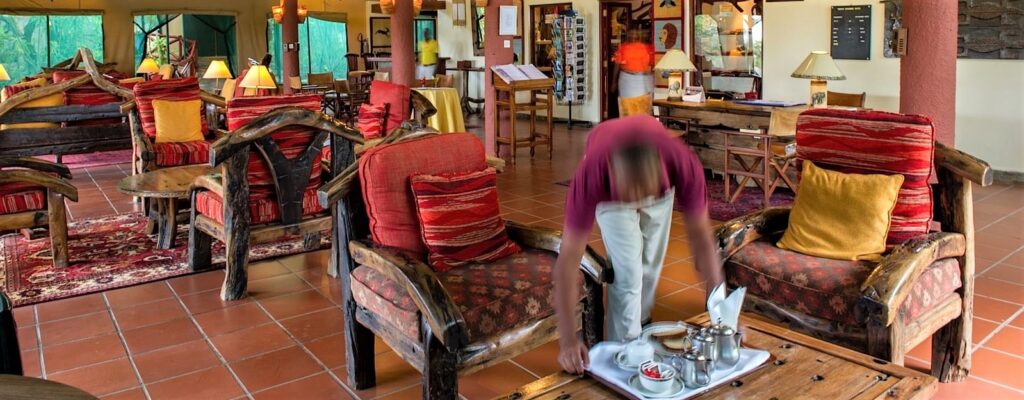
I have found the above to be basically true, although one detail is omitted – we are not to wander around after dark unaccompanied! Be inside our tent, flap zipped, after dark. Call security for an escort if we want to walk around. Yes, we have a phone in our tent. We’re to call for security, or room service, anytime we feel uneasy, or hungry. A big difference in this tented camp and our first two, as well as all the Lodges – they were FENCED IN. Although we were staying inside the Parks, the Park’s animals couldn’t roam around our tents/rooms. Until here. Have we seen a lion lurking? Well, not yet.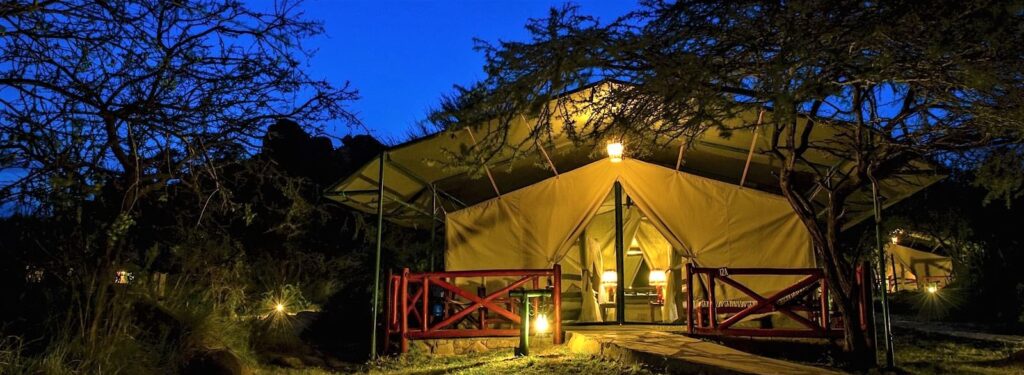
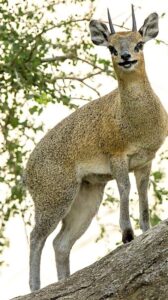 My curious self wanted to know more about this particular camp. What does Mbuzi Mawe mean? You’ll never guess, unless you’ve been studying your Swahili/Afrikaans/Dutch. Mbuzi Mawe translates to “klipspringer.” Which means: rock jumper, which is a very small antelope that lives on kopjes (also a Swahili/Afrikaans/Dutch word). Have I seen any klipspringer’s today, as I gazed at my kopjes? Well, not yet. These little fellows are tiny – less than two feet tall at the shoulder, weighing less than 40 pounds. Their yellowish-gray coat is great camouflage, and (like the lions) they mostly sleep during the day. I wish I’d seen them, or could tonight – it’s said the romantically inclined monogamous critters like to
My curious self wanted to know more about this particular camp. What does Mbuzi Mawe mean? You’ll never guess, unless you’ve been studying your Swahili/Afrikaans/Dutch. Mbuzi Mawe translates to “klipspringer.” Which means: rock jumper, which is a very small antelope that lives on kopjes (also a Swahili/Afrikaans/Dutch word). Have I seen any klipspringer’s today, as I gazed at my kopjes? Well, not yet. These little fellows are tiny – less than two feet tall at the shoulder, weighing less than 40 pounds. Their yellowish-gray coat is great camouflage, and (like the lions) they mostly sleep during the day. I wish I’d seen them, or could tonight – it’s said the romantically inclined monogamous critters like to 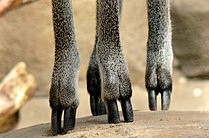 dance on the rocks in the moonlight. Imagine that, with their tiny odd hooves, Designed by Nature for ease of rock climbing. And yes, I said monogamous. Dad looks after Mom, and the kids. Something’s working for the klipspringer’s way of life: they are classified Least Concern by the IUCN with no major threats to their survival.
dance on the rocks in the moonlight. Imagine that, with their tiny odd hooves, Designed by Nature for ease of rock climbing. And yes, I said monogamous. Dad looks after Mom, and the kids. Something’s working for the klipspringer’s way of life: they are classified Least Concern by the IUCN with no major threats to their survival.
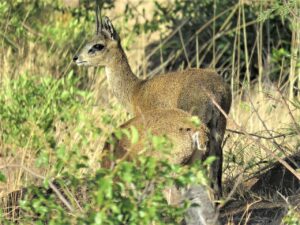 Note how they feed – one on lookout while the other eats. They’re so pretty, they almost look like painted dolls. Mbuzi Mawe! More pictures below (not mine) of the Mbuzi Mwae Tented Camp and the kopjes where both lions and klipspringers hang out.
Note how they feed – one on lookout while the other eats. They’re so pretty, they almost look like painted dolls. Mbuzi Mawe! More pictures below (not mine) of the Mbuzi Mwae Tented Camp and the kopjes where both lions and klipspringers hang out. 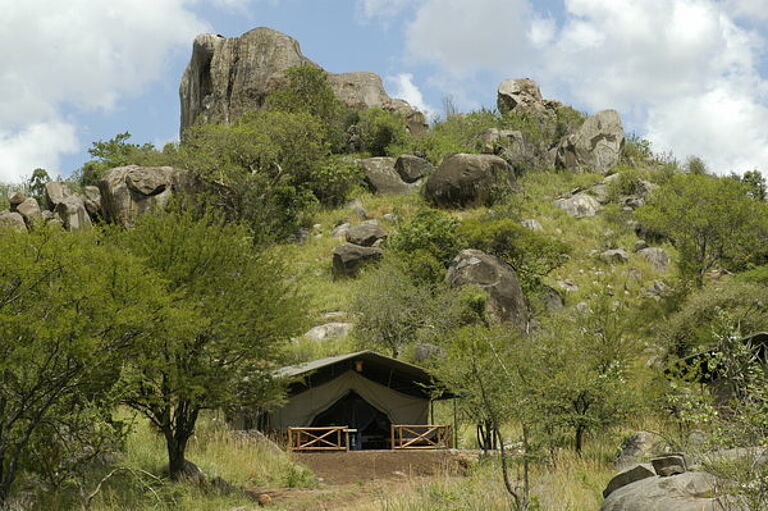
The above is our tent, note the yellow dining/lounge tent through the trees. Least walking!
Memories of my morning massage, as good as the kopjes for taking a nap.
Mbuzi Mawe Serena Tented Camp https://www.serenahotels.com/mbuzi-mawe
Serengeti National Park https://www.serengeti.com/
Next Post: Let Sleeping Lions
» September 23rd, 2022
There’s An Elephant In My Yard
Linda Lou Burton posting from Mbuzi Mawe Serena Tented Camp, Serengeti National Park, Tanzania–There’s an elephant in my yard. That’s one thing I never expected to say. Live long enough and things you never knew you’d enjoy just show up. It happened today. I sat on my lovely little tent porch and watched an elephant grazing in my front yard. By the end of the afternoon, I’d also watched buffalo, zebra, antelope, and an orange-shirted jogger out there between me and the kopjes. The hyraxes scampered around my porch while this was going on. Who needs to go on a game drive looking for animals!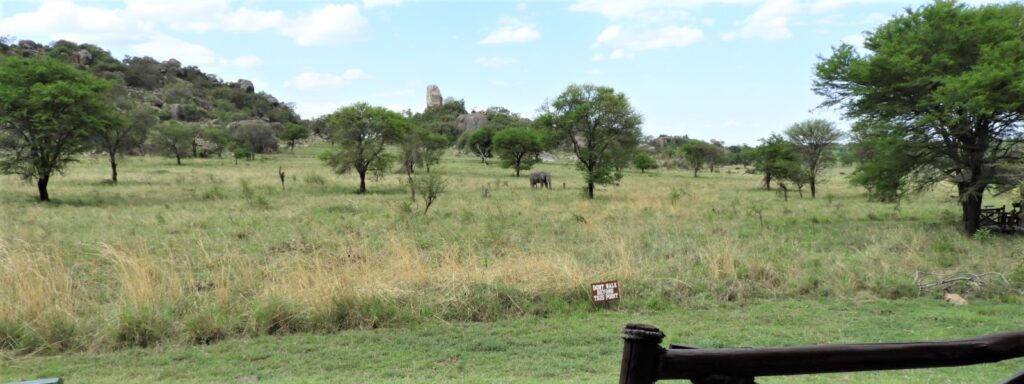
 I was practically catatonic this morning when the gang headed for the 4x4s and a full day on the Serengeti. Rick promised to share his photos with me, so I slept. And slept. New Star, the lovely lady who had welcomed me in yesterday, brought me tea and breakfast, inquiring about my welfare (I suppose she’d been consigned to do so). She also offered her services for a massage, and we agreed on a time. Now, between a massage, a grassy lawn, and a slow munching elephant, a person is about as relaxed as a person can ever hope to be. So, totally relaxed, I give you your lessons for the day – about elephants, and kopjes.
I was practically catatonic this morning when the gang headed for the 4x4s and a full day on the Serengeti. Rick promised to share his photos with me, so I slept. And slept. New Star, the lovely lady who had welcomed me in yesterday, brought me tea and breakfast, inquiring about my welfare (I suppose she’d been consigned to do so). She also offered her services for a massage, and we agreed on a time. Now, between a massage, a grassy lawn, and a slow munching elephant, a person is about as relaxed as a person can ever hope to be. So, totally relaxed, I give you your lessons for the day – about elephants, and kopjes.
My elephant today – I named him Fred – was a young male. Males leave their family groups when they reach puberty and live alone, or with other males, interacting with female family groups only when looking for a mate. Fred didn’t appear to be looking for anything today other than the next bite of grass; he was relaxed, contented, and unbothered (like me). Fred was a nice elephant! He was the first young male I’d spotted; I’d seen the matriarchal family units at Ol Pejeta, Maasai Mara, and Amboseli, either a female with her calves or several related females with offspring. The girls stick together, kicking the male calves out around the age of three. Some elephant factoids:
- Elephants are the largest existing land animals and can live up to 70 years.
- Elephant species existing today are the African bush, the African forest, and the Asian.
- Elephant trunks are used for breathing, bringing food and water to their mouth, and grasping things.
- Elephant tusks are used as weapons, and as tools for moving things and digging.
- Elephants communicate by touch, sight, smell, and sound, using infrasound and seismic communication over long distances.
- Elephants have self-awareness and appear to show empathy for dying and dead family members.
I already knew most of that about elephants, but I had never heard of kopjes (hoping my geology professor isn’t reading this, maybe I forgot!). Kopjes (pronounced KOP EES), are the rock formations making the backdrop for Fred across my grassy yard this afternoon. Massive rocks! Ancient rocks! They originally formed and cooled under the surface of the earth from volcanic activity; over millions of years the surrounding softer rocks eroded, leaving these incredible, beautiful “mountain islands.” Gneiss.
Why do lions, and leopards, hang out on the kopjes? What is nicer than a warm rock for a nap? Or what better vantage point for spotting dinner? A few more things make kopjes an interesting (and unique) environment.
- Water: hollows and cracks in the rocks store water for a long time, so mammals, birds, and plants can survive even if it’s completely dry all around.
- Plants: kopjes protect certain plants from mega-herbivores such as elephants and giraffe who can’t climb there; kopjes also protect plants from fires on the savannah.
- Nutrients: leaf litter and animal dung collect in the cracks of kopjes; lions and eagles bring their prey to the kopjes; all resulting in a flow of nutrients on a grand scale.
Pretty cool, these kopjes. But one thing I can’t puzzle out: it makes sense that my little rock hyraxes (I named them Ethel and Lucy) thrive on the kopjes and scamper every which way all day long. But why, I wondered, were the zebras, antelope, and even buffalo grazing peacefully beneath the kopjes this afternoon, possibly within view of a hungry lion? And why young Fred? And lord help us, why the orange-shirted jogger! See all below.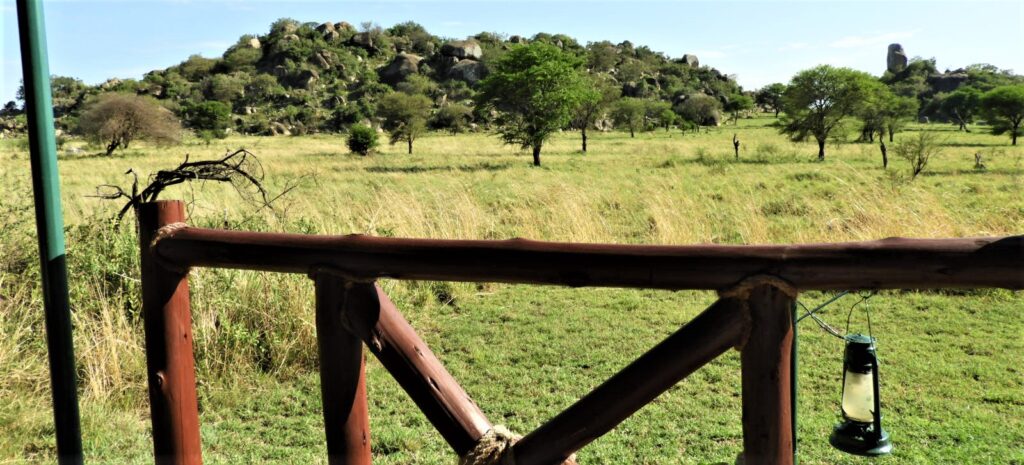
PS I tried my darndest to spot a tusk or flat nails on the hyraxes today, and even asked them if they were related to Fred, but they refused to comment. Be sure to note Lucy on top of the tent pole above my lounge chair. Ethel preferred to hang out on the bottom rail, watching Fred perhaps? Wondering?
Mbuzi Mawe Serena Tented Camp https://www.serenahotels.com/mbuzi-mawe
Serengeti National Park https://www.serengeti.com/
Next Post: You’ll Never Guess

